LimeMicro:LMS7002M Datasheet
Features summary
- Field Programmable Radio Frequency (FPRF) chip
- Dual transceiver, ideal for MIMO
- User programmable on-the-fly
- Continuous coverage of the 100 kHz - 3.8 GHz RF frequency range
- Digital interface to baseband with on-chip integrated 12 bit D/A and A/D converters
- Programmable RF modulation bandwidth up to 160 MHz using analog interface
- Programmable RF modulation bandwidth up to 60 MHz using digital interface
- Supports both TDD and full duplex FDD
- LimeLight™ digital IQ interface – JEDEC JESD207 TDD and FDD compliant
- Transceiver Signal Processor block employs advanced techniques for enhanced performance
- Single chip supports 2x2 MIMO. Multiple chips can be used to implement higher order MIMO
- On-chip RF calibration circuitry
- Fully differential baseband signals, analog IQ
- Few external components
- Low voltage operation, 1.25 V, 1.4 V, and 1.8 V. Integrated LDOs to run on a single 1.8 V supply voltage
- On-chip integrated microcontroller for simplified calibration, tuning and control
- Integrated clock PLL for flexible clock generation and distribution
- User definable analogue and digital filters for customised filtering
- RF and baseband Received Signal Strength Indicator (RSSI)
- 261-pin aQFN 11.5x11.5 mm package
- Power-down option
- Serial port interface
- Low power consumption, typically 880 mW in full 2x2 MIMO mode (550 mW in SISO mode) using external LDOs
- Multiple bypass modes for greater flexibility
Applications
- Broadband wireless communications
- GSM, CDMA2000, TD-SCDMA, WCDMA/HSPA, LTE
- IEEE® xxx.xxx radios
- Wi-Fi operating in the Whitespace frequencies
- Software Defined Radio (SDR)
- Cognitive Radio
- Unmanned Aerial Vehicle (UAV)
- Other Whitespace applications
Functional block diagram
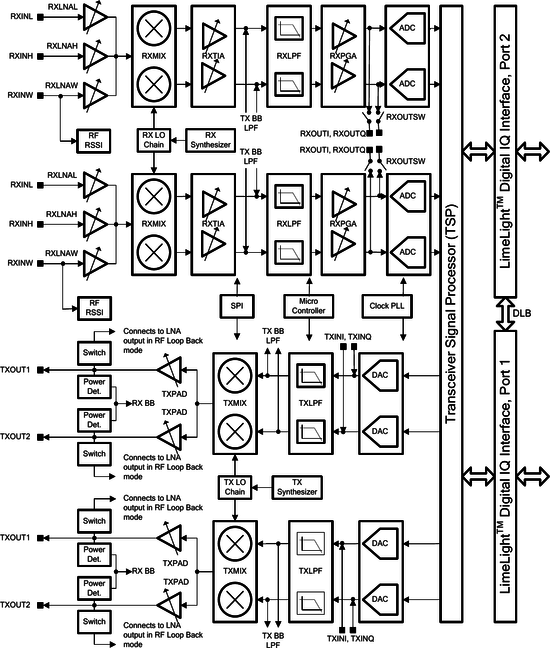
General description
The LMS7002M is a fully-integrated, multi-band, multi-standard RF transceiver that is highly programmable. It combines Low Noise Amplifiers (RXLNA), TX Power Amplifier Drivers (TXPAD) receiver/transmitter (RX/TX) mixers, RX/TX filters, synthesisers, RX gain control, TX power control, analogue-to-digital and digital-to-analogue converters (ADC/DACs) and has been designed to require very few external components.
The top level architecture of LMS7002M transceiver is shown in the functional block diagram. The chip contains two transmit and two receive chains for achieving a Multiple In Multiple Out (MIMO) platform. Both transmitters share one PLL and both receivers share another. Transmit and receive chains are all implemented as Zero Intermediate Frequency (Zero IF or ZIF) architectures providing up to 160MHz RF modulation bandwidth (equivalent to 80MHz baseband IQ bandwidth). For the purpose of simplifying this document, the explanation for the functionality and performance of the chip is based on one transmit and one receive circuitry, given that the other two work in exact the same manner.
On the transmit side, In-phase and Quadrature IQ DAC data samples from the base band processor are provided to the LMS7002M via the LimeLight™ digital IQ interface. LimeLight™ implements the JESD207 standard IQ interface protocol as well as de facto IQ multiplexed standard. JESD207 is Double Data Rate (DDR) by definition. In IQ multiplexed mode LimeLight™ also supports Single Data Rate (SDR). The IQ samples are then preprocessed by the digital Transceiver Signal Processor (TSP) for minimum analogue and RF distortion and applied to the on-chip transmit DACs. The DACs generate analogue IQ signals which are provided for further processing to the analogue/RF section. Transmit low-pass filters (TXLPF) remove the images generated by zero-hold effect of the DACs as well as the DAC out-of-band noise. The analogue IQ signals are then mixed with the transmit PLL (TXPLL) output to produce a modulated RF signal. This RF signal is then amplified by one of two separate, selectable power amplifier drivers and two open-drain differential outputs are provided as RF output for each MIMO path.
The LMS7002M provides an RF loopback option which enables the TX RF signal to be fed back into the baseband for calibration and test purposes. The RF loopback signal is amplified by the loopback amplifier in order to increase the dynamic range of the loop.
There are two additional loopback options implemented: one is an analogue baseband (BB) loopback; the other is a digital loopback (DLB). The analogue loop back is intended for testing while the DLB can be used to verify the LMS7002M connectivity to baseband, FPGA, DSP, or any other digital circuitry.
On the receive side three separate inputs are provided, each with a dedicated LNA optimised for narrow or wideband operation. Each port RF signal is first amplified by a programmable low-noise amplifier (RXLNA). The RF signal is then mixed with the receive PLL (RXPLL) output to directly down-convert to baseband. AGC steps can be implemented by a BB trans-impedance amplifier (RXTIA) prior to the programmable bandwidth low pass channel select/antialias filters (RXLPF). The received IQ signal is further amplified by a programmable gain amplifier (RXPGA). DC offset is applied at the input of RXTIA to prevent saturation and to preserve the receive ADC’s dynamic range. The resulting analogue receive IQ signals are converted into the digital domain with on-chip receive ADCs. Following the ADCs, the signal conditioning is performed by the digital Transceiver Signal Processor (TSP) and the resulting signals are then provided to the BB via the LimeLight™ digital IQ interface.
The analog receive signals can also be provided off-chip at the RXOUTI and RXOUTQ pins by closing the RXOUT switch. In this case it is possible to power down the on chip ADCs/TSP and use external parts, which can be very useful for more resource-demanding applications or where higher signal resolution is required. A similar option is also available on the TX side where the analogue signal can be processed by external components: the on-chip DACs/TSP can be powered down and analogue inputs can be provided at TXINI and TXINQ pins.
General specifications
| Parameter | Min. | Typ. | Max. | Unit | Condition/Comment |
|---|---|---|---|---|---|
| Operating temperature range | -40 | 25 | 85 | °C | |
| Storage temperature range | -65 | 25 | 125 | °C | |
| Operating frequency range | 30 0.1 |
3800 3800 |
MHz | Extended by TSP NCOs | |
| RF modulation bandwidth | 60 160 |
MHZ | Through digital interface Through analogue interface | ||
| Frequency resolution | 24.8 | Hz | Using 52MHZ PLL reference clock | ||
| Analogue supply voltage, high (VDDAH) | 1.71 | 1.8 | 1.89 | V | Used for TXPAD |
| Analogue supply voltage, medium (VDDAM) | 1.33 | 1.4 | 1.47 | V | Generated using integrated low-dropout regulators (LDOs) |
| Analogue supply voltage, low (VDDAL) | 1.2 | 1.25 | 1.3 | V | Generated using integrated LDOs |
| Digital core supply voltage | 1.1 | 1.2 | 1.3 | V | |
| TX supply current | 350 | mA | At -7 dBm output power, 2x2 MIMO, including the DACs and TSP | ||
| RX supply current | 420 | mA | For 2x2 MIMO, including the ADCs and TSP | ||
| Maximum RF output power | 0 | dBm | Continuous wave | ||
| PLL reference clock | 10 | 52 | MHz | ||
| Interpolation/decimation digital filters stop band suppression | 108 | dB |
General RF specifications
| Parameter | Min. | Typ. | Max. | Unit | Condition/Comment |
|---|---|---|---|---|---|
| RF channel frequency range | 30 0.1 |
3800 3800 |
MHz | Extended by TSP NCOs | |
| Transmit analogue input impedance | 400 | Ohms | Differential, programmable | ||
| Transmit load impedance at the output pins | 40 | Ohms | Differential, for maximum OIP3 | ||
| Transmit differential I and Q input current | 625 | μA | Differential, common mode | ||
| Transmit gain control range | 70 | dB | TXTSP and TXPAD combined | ||
| Transmit gain control step | 1 | dB | |||
| TX local oscillator (LO) leakage | -60 | dBc | Calibrated | ||
| RXLNAL frequency range | 0.1 | 2000 | MHz | Narrowband tunable, set by external matching circuit | |
| RXLNAH frequency range | 0.1 | 3800 | MHz | Narrowband tunable, set by external matching circuit | |
| RXLNAW frequency range | 0.1 | 3800 | MHz | Broadband tunable, set by external matching circuit | |
| Noise figure | 2.0 2.5 3.5 |
dB | at 0.95GHz at 2GHz at 3.8GHz | ||
| 2nd order input intercept point | 50 | dBm | Total receiver gain ~50 dB or more. Noise figure <3.5 dB in all bands. Two tone signals out of band. | ||
| 3rd order input intercept point | 4 | dBM | Total receiver gain ~50 dB or more. Noise figure <3.5 dB in all bands. Two tone signals out of band. | ||
| Receive gain control range | 70 | dB | RXLNA, RXTIA, RXPGA, and RXTSP combined | ||
| Receive gain control step | 0.5 | 1 | 1.5 | dB |
Two transmitter outputs (TXOUT1, TXOUT2) and three receiver inputs (RXINL, RXINH, RXINW) are provided to facilitate multi-band multi-standard operation. The functionality of the LMS7002M is fully controlled by a set of internal registers which can be accessed through a serial port and rapidly reprogrammed on the fly for advanced system architectures. In order to enable full duplex operation, LMS7002M contains two separate synthesisers (TXPLL, RXPLL), both usually driven from the same reference clock source PLLCLK.
Gain control
TX gain control
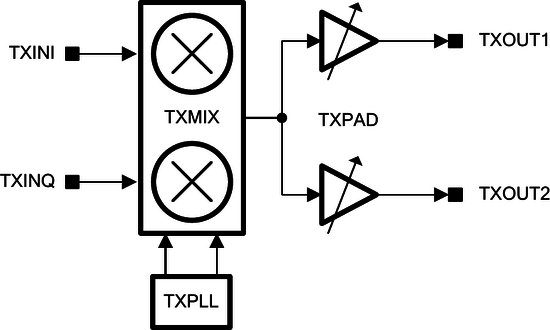
The LMS7002M transmitter has two programmable gain stages, where the TSP provides digital gain control and the TXPAD gives programmable gain of the RF signal.
| Parameter | Min. | Typ. | Max. | Unit | Condition/Comment |
|---|---|---|---|---|---|
| Digital TSP gain control range | 15 | dB | In steps of 1 LSB digital gain control | ||
| TXPAD gain control range | 55 | dB | |||
| TXPAD gain step size | 1 | dB | For the higher 10 steps | ||
| TXPAD gain step size | 2 | dB | For the lower 20 steps |
RX gain control
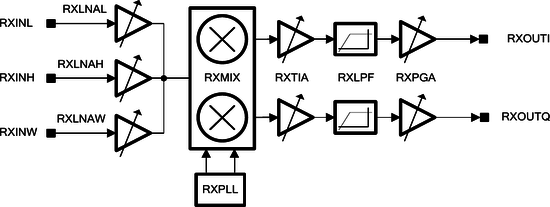
The LMS7002M receiver has three gain control elements, RXLNA, RXTIA, and RXPGA. If required, additional gain control can be implemented by RXTSP in digital domain. RXLNA gain control consists of 30 dB with 1 dB steps at high gain settings and 3 dB steps at low gain settings for AGC when large adjacent channel blockers are present and a reduction in system noise figure (NF) is acceptable. RXTIA offers 3 dB of control range. RXTIA is intended for AGC steps needed to reduce system gain prior to the channel filters when large in band blockers are present. This gain can be under the control of the baseband or fixed on calibration. RXPGA provides gain control for the AGC if a constant RX signal level at the ADC input is required. It has a 32 dB gain range control in 1 dB steps.
| Parameter | Min. | Typ. | Max. | Unit | Condition/Comment |
|---|---|---|---|---|---|
| Digital TSP gain control range | 15 | dB | In steps of 1 LSB digital gain control | ||
| RXLNA gain control range | 30 | dB | 1 and 3 dB steps | ||
| RXTIA gain control range | 3 | dB | |||
| RXPGA gain control range | 32 | dB | |||
| RXPGA gain step size | 1 | dB |
Synthesisers
The LMS7002M has two low phase noise synthesisers to enable full-duplex operation, and both are capable of output frequencies up to 3.8 GHz. Each synthesiser uses a fractional-N PLL architecture. The same reference frequency can be used for both synthesisers and is flexible between 10 to 52 MHz clock frequency. The synthesisers produce complex outputs with levels suitable to drive IQ mixers in both the TX and the RX paths. The transmit PLL could also be routed via switches to the receive PLL so as to offer phase-coherent operation in TDD mode.
PLL reference clock
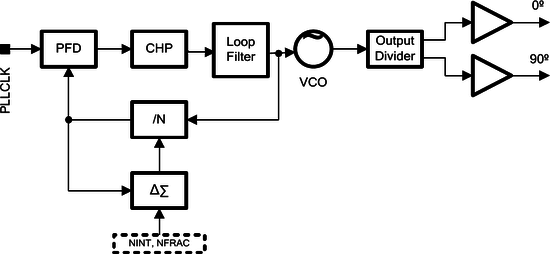
The LMS7002M can accept clipped sine as well as CMOS level signals for the PLL reference clock. Both DC and AC coupling are supported as shown in Figure 5. Internal buffer self-biasing must be enabled for AC coupling mode. The PLL reference clock input can also be low voltage CMOS (<1.2V) which is implemented by lowering the clock buffer supply.
DC coupled
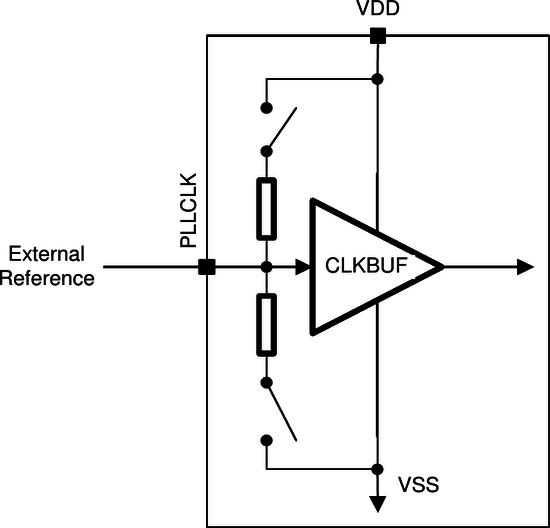
AC coupled
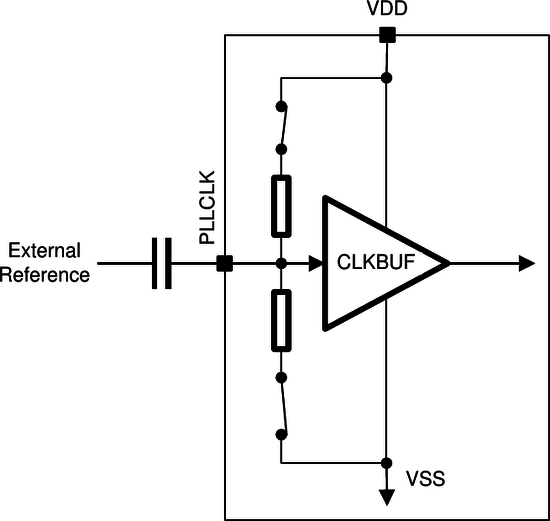
Synthesiser specifications
| Parameter | Min. | Typ. | Max. | Unit | Condition/Comment |
|---|---|---|---|---|---|
| Output frequency range | 30 | 3800 | MHz | ||
| Reference amplitude | 0.2 | 0.8 | 2.5 | Vpp | At PVDD >2.5 V |
| Reference frequency | 10 | 52 | MHz | For continuous LO frequency range | |
| Frequency resolution | 2.4 | Hz | Using 52 MHz PLL reference clock | ||
| 850 MHz Phase Noise 1 kHz offset 5 kHz offset 10 kHz offset 100 kHz offset 1 MHz offset 30 MHz offset |
-96 -97 -99 -107 -131 -158 |
dBc/Hz | |||
| 2.0 GHz Phase Noise 1 kHz offset 5 kHz offset 10 kHz offset 100 kHz offset 1 MHz offset 30 MHz offset |
-91 -92 -92 -102 -127 -158 |
dBc/Hz | |||
| 2.7 GHz Phase Noise 1 kHz offset 5 kHz offset 10 kHz offset 100 kHz offset 1 MHz offset 30 MHz offset |
-87 -88 -92 -98 -123 -158 |
dBc/Hz | |||
| 3.5 GHz Phase Noise 1 kHz offset 5 kHz offset 10 kHz offset 100 kHz offset 1 MHz offset 30 MHz offset |
-84 -85 -86 -89 -113 -152 |
dBc/Hz | |||
| Reference spurious outputs | -70 | -68 | dBc | ||
| Other spurious outputs | -60 | -55 | dBc | ||
| 850 MHz IQ phase error | 0.8 | 1 | degrees | After calibration | |
| 2000 MHz IQ phase error | 2 | degrees | |||
| 3500 MHz IQ phase error | 3 | degrees | |||
| IQ amplitude error | ±0.1 | ±0.2 | dB | ||
| PLL setting time | 50 | 150 | μS | Loop BW=70 kHz |
RF ports
The LMS7002M has two transmitter outputs and three receiver inputs for each of the dual transceivers. The optimum transmitter output load is 40 Ω differential at the output pads. The final stage amplifiers are open drain and require +1.8V voltage supply. The receiver inputs are common-source with different inductive degeneration, optimised for different frequency bands. They need to be externally matched for optimised narrowband performance or broadband utilising a wideband transformer.
TX and RX low-pass filters
The LMS7002M integrates selective low-pass filters in both the TX and RX paths. These filters have a programmable pass band in order to provide more flexibility on the DAC/ADC clock frequency and also to provide adjacent channel rejection in the receive chain. The complete filtering function is a combination of analogue filtering and digital TSP filtering. RX analogue filters are tunable from 0.7 MHz to 80 MHz. The digital filters provide a lower pass band of 0.7 MHz. Using such mixed mode filtering (digital and analogue) provides 60 dB antialias performance and 40 dB adjacent channel rejection as the worst case scenario. The TX filtering chain pass band is tunable from 2 MHz to 80 MHz. When combined with TX digital filters the chain offers enhanced performance in a similar way to the RX analogue/digital filtering chain.
TX analogue filter chain
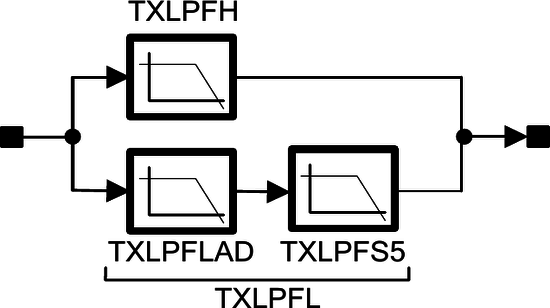
The transmitter baseband has three independently controlled low pass filter stages:
- 4th order ladder filter (TXLPFLAD)
- 1st order real pole filter (TXLPFS5)
- 2nd order high-band filter (TXLPFH)
The low-band filter (TXLPFL) path pass band is tunable from 2 MHz to 20 MHz and is comprised of two filter stages: 4th order low pass ladder filter (TXLPFLAD) and 1st order low pass real pole filter (TXLPFS5). The real pole stage filters the BB noise at the duplex frequency to meet the far-end noise specifications in some FDD systems. The high-band filter (TXLPFH) pass band is tunable from 20 MHz up to 80 MHz and is comprised of a single 2nd order low pass stage. Only one path (TXLPFL or TXLPH) can be active at the same time.
RX analogue filter chain
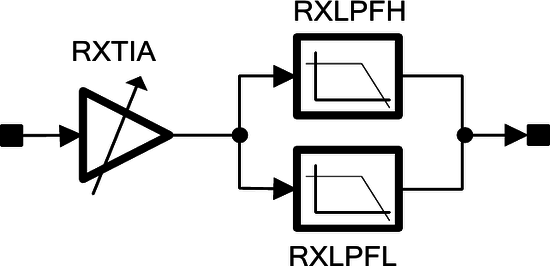
The receiver baseband has three independently controlled low pass filter stages:
- 1st order single pole filter (RXTIA)
- 2nd order low band filter (RXLPFL)
- 2nd order high band filter (RXLPFH)
The initial filtering is done by the transimpedance amplifier (RXTIA), which acts as a single-pole low-pass filter. The RXTIA output is routed to one of two filter stages. Low band filter pass band is tunable from 0.75 MHz up to 20 MHz. High band filter pass band is tunable from 20 MHz up to 80 MHz. Both low band and high band stages are 2nd order low pass filters. Paired with the RXTIA, these stages produce a 3rd order low pass filter response. Only one path (RXLPFL or RXLPH) can be active at the same time.
Analogue TX LPFH amplitude response
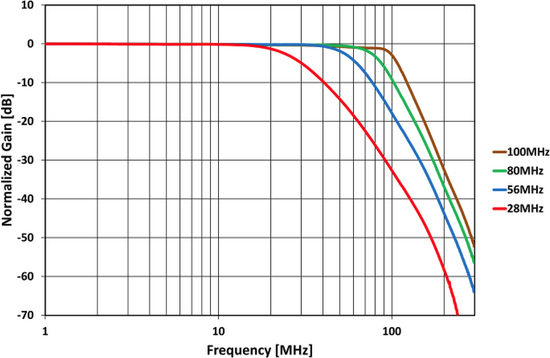
Analogue TX LPFL amplitude response
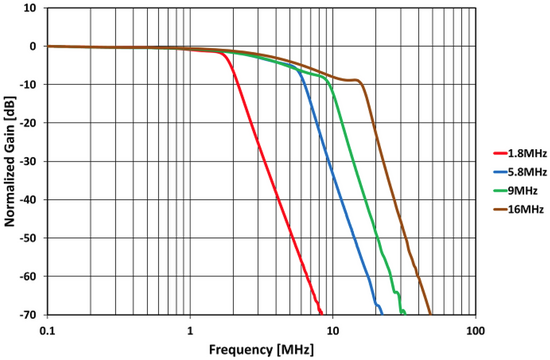
Analogue RX LPFH amplitude response
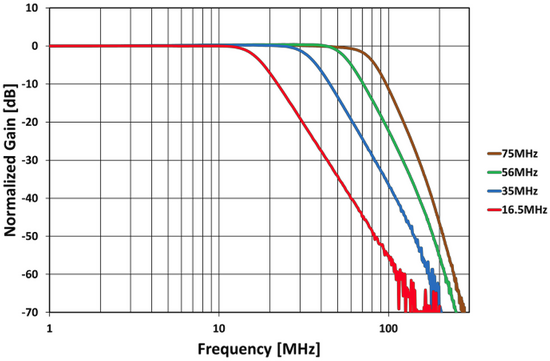
Analogue RX LPFL amplitude response
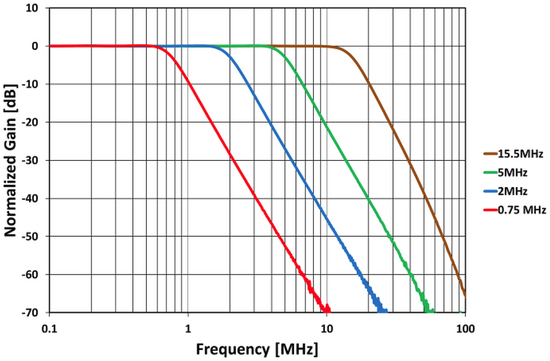
Transceiver signal processor
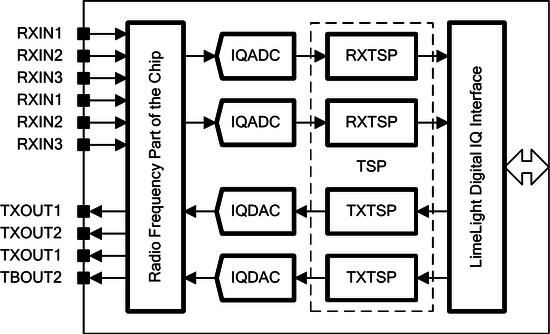
The LMS7002M includes a high digital gate count within the Transceiver Signal Processor (TSP) block. The function of the TSP is to employ advanced digital signal processing techniques to enhance the performance of the analogue/RF parts. This results in improved performance of the overall system and a saving on total current consumption. The TSP is placed between the data converters and the LimeLight™ digital IQ interface. Functionally, the RX and TX parts of the TSP are similar
In both the TX and RX TSP blocks there are three general-purpose finite impulse response (FIR) filters, G.P. FIR 1, G.P. FIR 2, and G.P. FIR 3. The filter coefficients are fully programmable and the implementation does not force their impulse response to be symmetrical.
On the TX side one of these filters could be used as a phase equaliser, which is a requirement in some communication standards such as CDMA2000. Another can be used to flatten the amplitude response of the TXLPF, while the third FIR could be used to further enhance the channel filtering function of the BB modem. If phase equalisation is not required then one filter can be used to minimise group delay variation of the analog TXLPF. Possible applications of the G.P. FIR filters on the RX side are similar. One could be used to minimise group delay variation of the analogue RXLPF while another could help to improve RXLPF adjacent channel rejection performance.
The interpolation block within the TXTSP takes IQ data from the BB modem and increases the data sample rate. The advantages of having interpolation are as follows: for narrow band systems (GSM/EDGE) or even moderately broad band (WCDMA, CDMA2000) modulation standards the BB modem does not need to interpolate IQ data to the target system clock. The base band can provide output data at a much lower sample rate saving on power at the digital interface. Having a low data rate interface also simplifies the PCB design. However, the interpolator block generates data samples at the system clock rate, so the DACs run at a high sampling rate. As the DACs are running at a high frequency, it means that the quantisation noise is spread over a wider frequency range which results in a better overall SNR. Also, the image generated by the DAC zero hold effect is further away from the wanted signal hence the specification for the TXLPF can be relaxed.
The reason for having decimation in the RXTSP is similar to that of interpolation in TXTSP. The ADCs can run at high frequency, and the specification of the RXLPF used as an anti-alias filter in this case is relaxed, the G.P. FIR improves adjacent channel rejection and the decimation circuit reduces the received data sample rate before sending the data to the BB modem.
The two Numerically Controlled Oscillators (NCO) and digital complex mixer (CMIX) in the TXTSP and RXTSP paths enable the LMS7002M to run in low digital IF.
Inverse sinc filters (INVSINC) within the TXTSP chain compensate for sinx/x amplitude roll off imposed by the DACs themselves.
The Tx DC Corr block is used to cancel residual DC offset of TXLPF. It is also used to cancel TX LO leakage feed-through as mentioned earlier.
There are three sources of the DC component at the RX output. These are the residual DC offset of the RXPGA and RXLPF, RX LO leakage feed-through and second order distortion (IP2). The Rx DC Corr blocks compensate for all of these sources of offset. The block is implemented as a real time tracking loop so any change of the RX DC due to either the signal level change, or due to RX gain change as well as any temperature effect will be tracked and cancelled automatically.
The IQ Gain Corr and IQ Phase Corr blocks correct IQ imbalance in both TXTSP and RXTSP in order to minimise the level of unwanted sideband (image) component.
The last stage in the RXTSP path is a digital implementation of an Adaptive Gain Control (AGC) loop. Assuming that the BB modem does not require 12-bit full scale ADC outputs, the digital AGC block can provide a certain level of automatic gain control before the BB involves RF and IF gain stages.
RXTSP structure

TXTSP structure

IQ gain correction
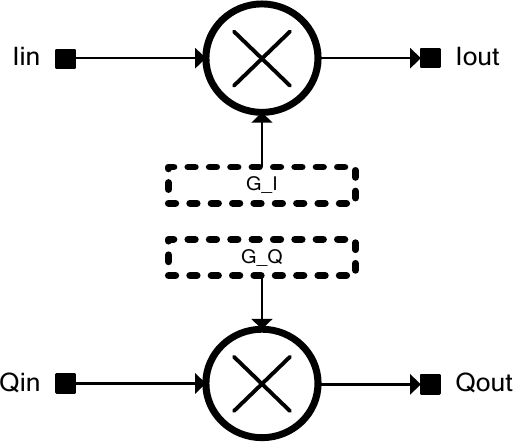
This block implements the following equation:
and are programmable correction factors which are altered by the BB modem to minimise any unwanted sideband component. The BB modem can combine IQ gain correction and digital gain control using the same module by calculating and in the following way:
where and are IQ gain correction factors and is the desired digital gain.
IQ phase correction
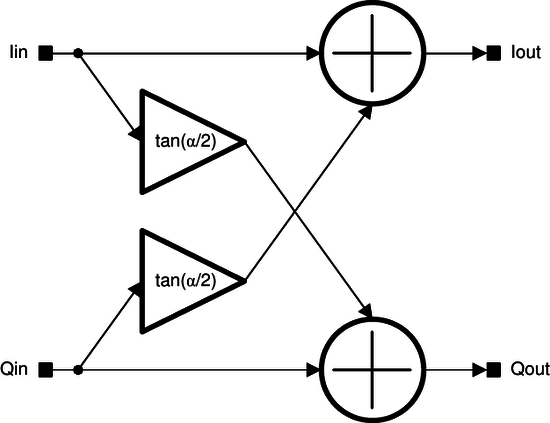
IQ phase correction is in fact equivalent to vector rotation. If the quadrature phase error is then the I and Q vectors are both rotated by but in opposite directions, hence IQ outputs of the corrector circuit are 90° phase shifted. IQ phase correction equations are given below:
The value of should be stored in the configuration register as a programmable correction parameter. The BB modem should adjust this value to minimise the unwanted side band component. The BB modem can also use the following approximation formula:
when is small, which is usually the case. The IQ phase corrector of the LMS7002M is designed to correct an IQ phase error up to ±20°.
TX DC correction
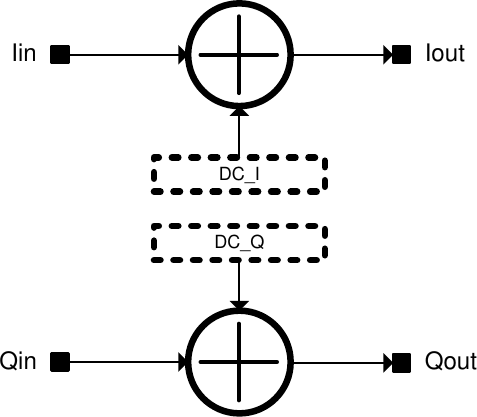
DC offset correction in the TXTSP path is achieved by using the following equation:
Here and are programmable DC offset correction parameters which the BB modem should adjust to minimise the TX DC and TX LO leakage feed-through.
RX DC correction
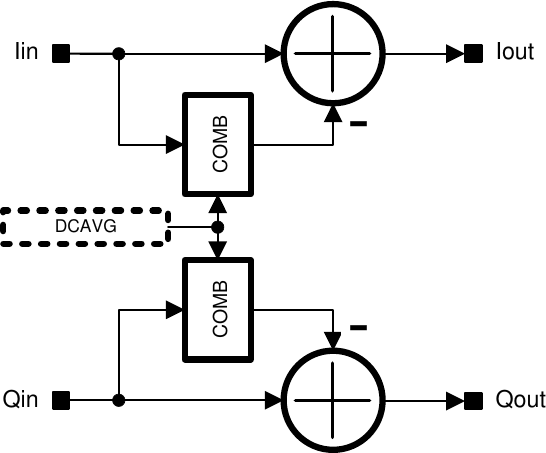
As mentioned previously, there are multiple reasons for DC to appear at the RX output. The most difficult to correct, in a static manner, is the second order distortion (IP2) component which changes with the RX input level as well as the RX gain set up. A compensation loop running in real time is required to track and correct the DC at the RX output. A simple digital implementation of such a loop is given above.
The averaging (COMB) filter calculates the DC of the corrector input and subtracts it to cancel out the offset. The loop is running all the time so any change of the RX DC due to the signal level change, RX gain change, or temperature will be tracked and cancelled automatically. The only programmable parameter in the loop is DCAVG which defines the averaging window size.
Inverse SINC filter
The inverse sinc filter compensates for sinx/x amplitude roll off imposed by the DAC. The filter is designed to compensate from DC to 0.35fs where fs is the DAC sampling frequency. Impulse and amplitude responses are shown in Figure 19 and Figure 20.a respectively. Figure 20.b plots the equivalent DAC amplitude response with the inverse sinc function compensation applied. The in band (0 – 0.35fs ) amplitude ripple is less than +/- 0.04 dB.
INVSINC impulse response
h( 0) = 0.0101318 = h( 4) h( 1) = -0.0616455 = h( 3) h( 2) = 0.855469
INVSINC (a) and equivalent DAC (b) amplitude response
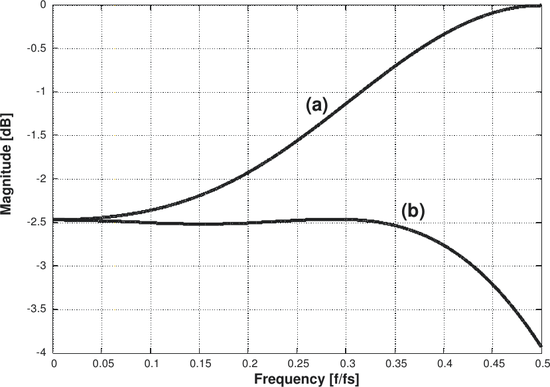
Complex mixer
The complex mixer used in the RXTSP and TXTSP is designed to implement the following set of equations:
where and are provided from the IQ pre-processing stages while cosine and sine signals are generated by the NCO. An option to choose the sign in the mixing equations is implemented which gives the ability to do up-mixing or down-mixing in both TX and RX chains.
Numerically-controlled oscillator
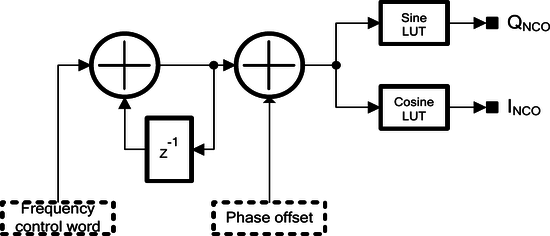
The quadrature carrier signal, required to implement low digital IF, is generated by the local NCO. The internal NCO design is based on a Direct Digital Frequency Synthesis (DDFS) algorithm with a 32-bit phase accumulator with 19-bit phase precision and provides 14-bit digital sine and cosine waveforms with spurious performance better than –114 dBc.
The carrier frequency generated by the NCO is defined using the following formula:
where represents the decimal value of the 32-bit frequency control word and is the NCO clock frequency.
Carrier phase offset can also be adjusted using the 16-bit configuration parameter . The carrier phase shift is calculated as follows:
with being the decimal value stored in the carrier phase offset register.
Both frequency control and phase control words are easily accessible via SPI, therefore NCOs can be modulated by direct symbol insertion. Up to 16FSK or 16PSK modulations are supported.
Interpolation

Interpolation within the TXTSP channel is implemented using the chain of five fixed coefficients half band FIR filters. Each sub-filter in the chain interpolates by two. The interpolation ratio of the overall filter is set by selecting one of the sub-filter outputs and adjusting the clock rates accordingly. Hence, the interpolation ratio can be programmed to be:
Interpolation by 1 is achieved by bypassing all the interpolation filters. The filters are designed to provide a wide signal pass band from DC to where:
Scaling factor in the equation above, for = 2, 4, 8, 16, or 32, should be set to one of the following values:
- <= 0.27 for >= 108dB interpolation image suppression
- <= 0.30 for >= 75dB interpolation image suppression
- <= 0.32 for >= 60dB interpolation image suppression
can be used to trade off interpolation image suppression for the interpolation filter pass band.
For , should be set to to limit the signal BW below the Nyquist limit, making room for analogue TX filters to operate. There is no interpolation image in this case hence more flexibility to set for higher IF/RF bandwidth.
Only two different configurations are used within the filtering chain of the NCO implementation: HB1 and HB2. The impulse and amplitude response of HB1 are provided below. The remaining three filters (HB2A, HB2B and HB2C) are all the same with their coefficients and amplitude response also given below. The overall interpolator can provide image suppression of better than –108 dB with negligible amplitude distortion (pass band ripple less than 10-5 dB).
HB1 impulse response
h( 0) = -4.673e-05 = h(30) h( 1) = 0 = h(29) h( 2) = 0.000392914 = h(28) h( 3) = 0 = h(27) h( 4) = -0.00181007 = h(26) h( 5) = 0 = h(25) h( 6) = 0.00600147 = h(24) h( 7) = 0 = h(23) h( 8) = -0.0160789 = h(22) h( 9) = 0 = h(21) h(10) = 0.0378866 = h(20) h(11) = 0 = h(19) h(12) = -0.0882454 = h(18) h(13) = 0 = h(17) h(14) = 0.3119 = h(16) h(15) = 0.5
HB1 amplitude response
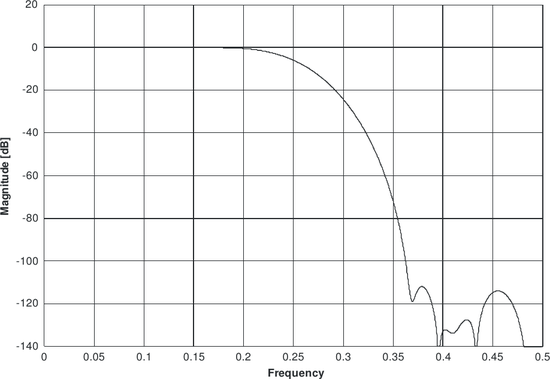
HB2 impulse response
h( 0) = -0.00164032 = h(14) h( 1) = 0 = h(13) h( 2) = 0.0138855 = h(12) h( 3) = 0 = h(11) h( 4) = -0.0630875 = h(10) h( 5) = 0 = h( 9) h( 6) = 0.300842 = h( 8) h( 7) = 0.5
HB2 amplitude response
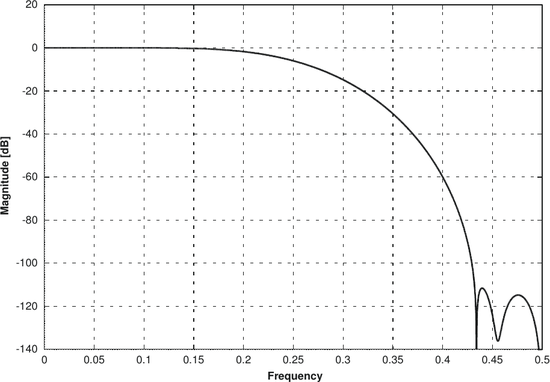
Decimation

The decimation function is implemented using the same filters as in the case for interpolation although the hardware is simplified slightly by taking advantage of only having to provide every second sample at the sub-filters output. Decimation ratio can be programmed to be:
Decimation by 1 is achieved by bypassing all the decimation filters. Decimator performance is the same as the performance of the interpolator i.e. pass band is:
As before, scaling factor in the equation above, for = 2, 4, 8, 16, or 32, should be set to one of the following values:
- <= 0.27 for >= 108dB decimation alias suppression
- <= 0.30 for >= 75dB decimation alias suppression
- <= 0.32 for >= 60dB decimation alias suppression
Again, can be used to trade off decimation alias suppression for the decimation filter pass band.
For , should be set to to limit the signal BW below the Nyquist limit, making room for additional filtering in BB, if required. There is no decimation alias in this case hence more flexibility to set for higher IF/RF bandwidth.
General-purpose FIR filters

The LMS7002M features general-purpose filters 1 and 2, which are based on a Multiply and Accumulate (MAC) FIR architecture. They can implement up to a 40-tap filtering function and the coefficients are fully programmable via SPI. The hardware implementation does not impose the constraint for the filter impulse response to be symmetrical hence the filter phase response can but does not need to be ideally linear. Therefore it can be used in general filtering as well as nonlinear applications which can be used to implement phase equalisation.
The filter coefficients are stored in five 8x16-bit internal memory banks as two’s complement signed integers, where is related to the filter length as follows:
Grey locations in the above memory bank diagram highlight the memory registers which are set to zero for . Evidently, the number of the filter taps is limited by the size of the coefficients memory to:
The following relationship should be satisfied:
being the interpolation or decimation ratio, for the MAC hardware to be able to produce output samples on time.
General purpose FIR filter 3 hardware is composed of three filters (each equivalent to G.P. FIR 1 or 2) running in parallel in order to increase its processing power, hence it can implement the filters with:
It can be used as a channel select filter or for any other purpose which requires a larger number of filtering taps.
Received signal strength indicators
A digital received signal strength indicator (RSSI) circuit calculates the level of the received complex signal () as follows:
The following approximation of the square root is implemented in the chip:
where:
The same RSSI block is used within the digital AGC loop. If digital AGC is not required then the RSSI output, after being averaged by the COMB filter, can be provided back to the BB modem via SPI as shown under automatic gain control. In this way the BB can control RF and IF gain stages to implement analogue AGC in which case the AGC loop is closed via the BB modem.
There is also an RF RSSI block implemented in the RF front end connected to the input of the wideband LNA. This block can be used to detect the presence of large interferers so the BB modem can adjust RX gain stages very quickly to counteract such scenarios. The RF RSSI output is routed to I ADCs of RX channel 1 or RX channel 2. When the RSSI output is to be read, the main RX path of that channel should be disabled. Also, RF RSSI analog output can be provided off-chip at the test pin and further processed by external circuits. In this case none of the RX paths needs to be disabled. The RSSI detects the input from -70 dBm to -20 dBm, corresponding to the full dynamic range of the ADC.
Automatic gain control

The AGC loop functions as follows:
- “Square root of two” (RSSI) block calculates the RMS of the AGC output.
- This signal is averaged by the COMB filter. The averaging window size AVG is programmable via SPI.
- An error signal is then calculated as the difference between the desired output signal level and the measured one. The desired amplitude level ADESIRED is programmable via SPI.
- After the loop gain stage, the error is integrated to construct the digital VGAs gain control signal. Loop gain K is programmable via SPI.
- VGAs gain cannot be negative and should not be zero either, hence max(1,x) module is provided in the feedback path.
Possible applications
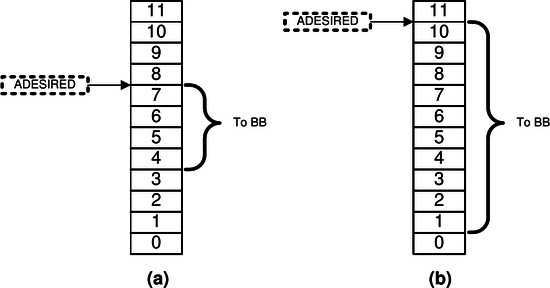
The first example (a) shows the case where the BB modem expects 4 bits instead of full 12-bit ADC output. In this case, the ADESIRED loop parameter is set as shown in the figure, the gain of RF and IF stages are set for ADC not to produce full scale but ADESIRED level instead. The middle 4 bits are provided to BB. If the RF input signal level goes higher or lower, AGC will adapt the gain to keep its output at ADESIRED value so bits 7 to 4 will always contain 4 MSBs of the received signal. Since we have 4 bits on top and 4 bits below the middle 4 bits, the loop itself provides ±24 dB automatic gain control range without using RF and IF gain stages. The second example shown (b) is a more general case. The BB modem will receive 10 bits while the loop provides ±6 dB gain control range without engaging RF and IF gain blocks.
LimeLight™ digital IQ data interface
The LMS7002M implements a LimeLight™ digital IQ interface to the BB modem. LimeLight™ can be configured to run in one of the following three modes:
- JESD207 mode
- TRXIQ double data rate (DDR) mode
- TRXIQ single data rate (SDR) mode
All three modes are capable of supporting both TDD and FDD operation. The data throughput of JESD207 and TRX DDR is high enough to connect to up to 2x2 MIMO BB modems. TRXIQ SDR mode is backward compatible to the LMS6002D digital IQ interface.
JESD mode
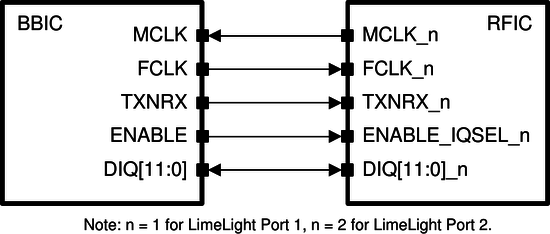
This figure shows typical connectivity between the LMS7002M and the BB modem with LimeLight™ running in JESD207 mode. LimeLight™ uses two such ports to support FDD. Signalling is defined by the JESD207 standard itself as specified by JEDEC.
TRIXIQ mode
Connectivity in TRXIQ DDR and SDR modes is the same. The only difference is that in DDR mode the BB and RF chips sample at both edges of FCLK/MCLK.
TRXIQ-TX mode
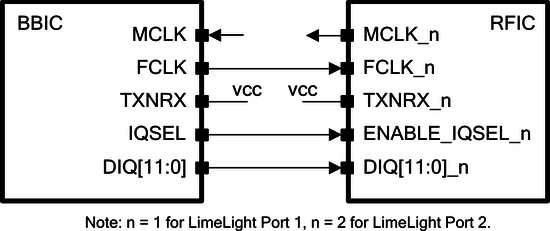
In TRXIQ-TX mode the BB modem provides IQSEL, DIO[11:0] and FCLK. The LMS7002M captures data using one or both edges of FCLK.
TRXIQ-RX mode
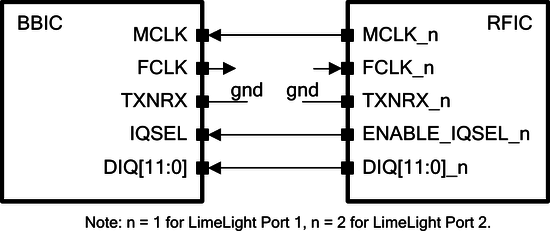
In TRXIQ-RX mode, the LMS7002M provides IQSEL, DIO[11:0] and MCLK. The BB modem captures data using one or both edges of MCLK.
Timing diagrams
Data path transmit burst start, JESD207 mode

Data path transmit burst finish, JESD207 mode

Data path receive burst start, JESD207 mode

Data path receive burst finish, JESD207 mode

Receive data path, TRXIQ double data rate (DDR) mode

Transmit data path, TRXIQ double data rate (DDR) mode

Receive data path, TRXIQ single data rate (SDR) mode

Transmit data path, TRXIQ single data rate (SDR) mode

Implementing a low-voltage digital IQ interface
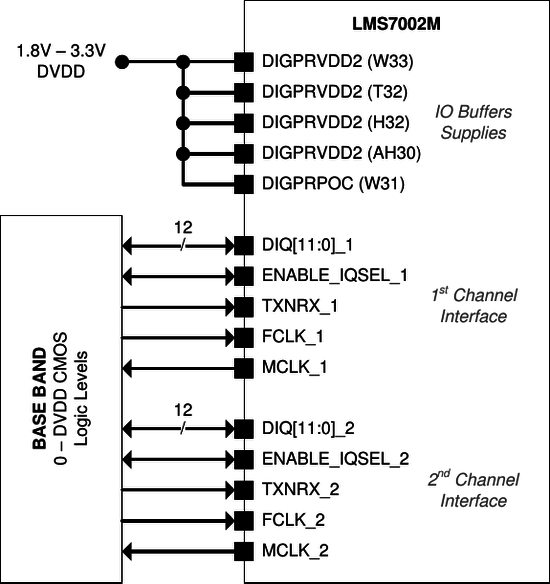
The digital IO buffers of the LMS7002M are supplied using four pins (pin name – DIGPRVDD2, pin ID – W33, T32, H32, AH30). All these pins must be supplied by the same supply DVDD. There is one additional supply pin (pin name – DIGPRPOC, pin ID – W31) which performs Power On Control (POC) function for digital pads. To implement a low voltage digital interface, DVDD can be lowered to 1.8 V. If DVDD = 1.8V then all data lines shown in the above diagram must also be set to 1.8 V CMOS Ios for correct interface operation.
IQ interface timing parameters
| Parameter | Min. | Typ. | Max. | Unit |
|---|---|---|---|---|
| Data setup time (tSETUP) | 1 | ns | ||
| Data hold time (tHOLD) | 0.2 | ns | ||
| Data output delay (tOD) at 15 pF load | 6 | ns |
Digital IQ interface IO buffers specification
| Parameter | Min. | Typ. | Max. | Unit | Condition/Comment |
|---|---|---|---|---|---|
| Supply voltage (PVDD) | 1.7 | 2.5 | 3.6 | V | Can go below 2.5 V nominal to support LV CMOS signalling |
| Input high VIH | PVDD-0.8 | V | |||
| Input low VIL | 0.8 | V | |||
| Output high VOH | PVDD-0.4 | V | |||
| Output low VOL | 0.4 | V | |||
| Input pad capacitance CIN | 3.5 | pF | |||
| Output drive current | 8 | mA |
DACs electical specifications
| Parameter | Min. | Typ. | Max. | Unit | Condition/Comment |
|---|---|---|---|---|---|
| Digital core supply | 1.1 | 1.2 | 1.3 | V | Generated using integrated LDOs |
| Analogue supply | 1.1 | 1.2 | 1.3 | V | Generated using integrated LDOs |
| Number of bits | 12 | bits | Two's complement format | ||
| DAC sampling rate | 640 | MHz | |||
| Full scale current | 625 | uA | Programmable | ||
| SFDR | 63 62 |
dBc | Fin=10MHz, -1dBFS Fin=37MHz, -2dBFS | ||
| ENOB | 9 | bits |
ADCs electrical specification
| Parameter | Min. | Typ. | Max. | Unit | Condition/Comment |
|---|---|---|---|---|---|
| Digital core supply | 1.1 | 1.2 | 1.3 | V | Generated using integrated LDOs |
| Analogue supply | 1.1 | 1.2 | 1.3 | V | Generated using integrated LDOs |
| Number of bits | 12 | bits | Two's complement format | ||
| ADC sampling rate | 160 | MHz | |||
| Input amplitude | 0.8 | Vpp | Differential | ||
| Input common mode voltage | 0.55 | V | |||
| SFDR | 63 62 |
dBc | Fin=10MHz, -1dBFS Fin=37MHz, -2dBFS | ||
| ENOB | 9 | bits |
Serial Port Interface
The functionality of the LMS7002M transceiver is fully controlled by a set of internal registers which can be accessed through a serial port interface. Both write and read SPI operations are supported. The serial port can be configured to run in 3 or 4 wire mode with the following pins used:
- SEN
- serial port enable, active low
- SCLK
- serial clock, positive edge sensitive
- SDIO
- serial data in/out in 3 wire mode
serial data input in 4 wire mode - SDO
- serial data out in 4 wire mode
don't care in 3 wire mode
Serial port key features:
- 32 SPI clock cycles are required to complete a write operation.
- 32 SPI clock cycles are required to complete a read operation.
- Multiple write/read operations are possible without toggling serial port enable signal.
All configuration registers are 16 bits wide. The write/read sequence consists of a 16-bit instruction followed by 16-bit data to write or read. MSB of the instruction bit stream is used as SPI command where CMD = 1 for write and CMD = 0 for read. Next 4 bits are reserved (Reserved[3:0]) and must be zeroes. Next 5 bits represent module address (Maddress[4:0]) since the LMS7002M configuration registers are divided into logical blocks as shown. The remaining 6 bits of the instruction are used to address particular registers (Reg[5:0]) within the block. Maddress and Reg compiles global 11-bit register address when concatenated ((Maddress << 6) | Reg).
Note that the write operation is the same for both 3-wire and 4-wire modes. Although not shown, multiple write/read is possible by repeating the instruction/data sequence while keeping SEN low.
SPI timing parameters
| Parameter | Min. | Typ. | Max. | Unit |
|---|---|---|---|---|
| Clock frequency, 4-wire mode 3-wire mode |
50 | MHz | ||
| 20 | MHz | |||
| Enable setup time (tES</sub) | 2 | ns | ||
| Enable hold time (©) | 0.2 | ns | ||
| Data set up time (tDS) | 1 | ns | ||
| Data hold time (tDH) | 0.2 | ns | ||
| Data output delay (tOD) at 12 pF load | 6 | ns |
SPI write cycle, 3-wire and 4-wire modes

SPI read cycle, 4-wire mode (default)

SPI read cycle, 3-wire mode

SPI memory map
The LMS7002M configuration registers are divided into a number of logical blocks.
Integer and fractional parts of the PLL feedback divider are stored in a number of configuration memory registers. To change their values, multiple SPI write cycles are required. Hence, the controlled PLL will continue to output at the previously selected frequency until all NINT and NFRAC registers are updated. Otherwise it would generate an unpredictable and incorrect LO frequency while being configured. Such parameters are provided through shadow registers. Shadow registers are clocked by the PLL reference clock and output new values simultaneously at first positive clock edge after SEN goes high, i.e. after update of shadowed parameters via SPI is finished.
| Module description | Module address [4:0] | Register address space [5:0] |
|---|---|---|
| Microcontroller (MCU) | 00000 | 00xxxx |
| LimeLight port | 00000 | 1xxxxx |
| Top control (AFE, BIAS, XBUF, CGEN, LDO, BIST) | 0001x | xxxxxx |
| TRX (TRF(A/B), TBB(A/B), RFE(A/B), RBB(A/B), SX(R/T) | 0010x | xxxxxx |
| TxTSP(A/B) | 01000 | 0xxxxx |
| TxNCO(A/B) | 01001 | xxxxxx |
| TxGFIR1(A/B) | 01010 | xxxxxx |
| TxGFIR2(A/B) | 01011 | xxxxxx |
| TxGFIR3a(A/B) | 01100 | xxxxxx |
| TxGFIR3b(A/B) | 01101 | xxxxxx |
| TxGFIR3c(A/B) | 01110 | xxxxxx |
| RxTSP(A/B) | 10000 | 0xxxxx |
| RxNCO(A/B) | 10001 | xxxxxx |
| RxGFIR1(A/B) | 10010 | xxxxxx |
| RxGFIR2(A/B) | 10011 | xxxxxx |
| RxGFIR3a(A/B) | 10100 | xxxxxx |
| RxGFIR3b(A/B) | 10101 | xxxxxx |
| RxGFIR3c(A/B) | 10110 | xxxxxx |
Implementing low-voltage SPI
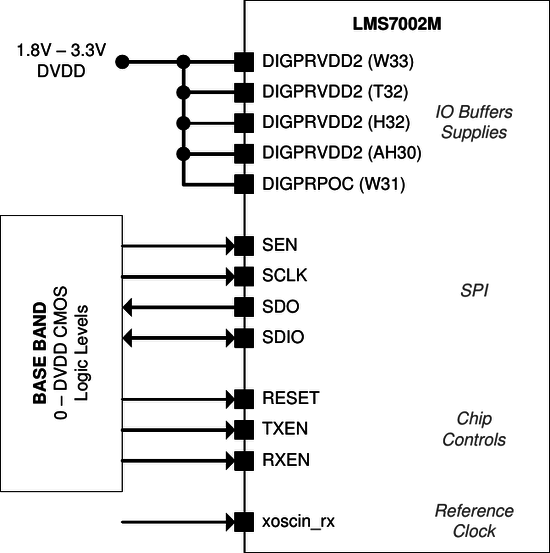
Digital IO buffers in the SPI region are all supplied from the same pins as the digital IQ interface (pin name – DIGPRVDD2, pin ID – W33, T32, H32, AH30). All these pins must be supplied by the same supply DVDD. There is one additional supply pin (pin name – DIGPRPOC, pin ID – W31) which controls the power on circuitry of the digital pads. To implement a low voltage SPI interface, DVDD can be lowered to 1.8V. If DVDD=1.8V then all data lines in the above figure must also be set to 1.8V CMOS Ios for correct interface operation. The PLL reference clock input level is controlled independently of the DVDD voltage. By default it is 1.8V, but can be further lowered to 1.2V by chip controls if needed.
On-chip microcontroller
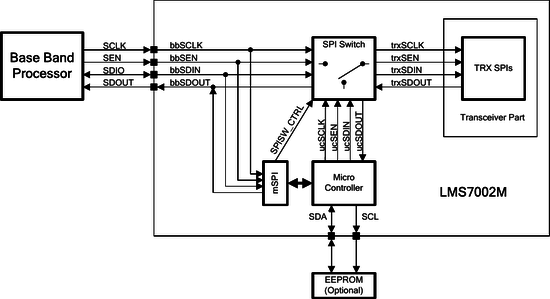
The LMS7002M can be fully controlled by external BB/DSP/FPGA ICs using 4-wire or 3-wire serial port interface. The controlling processor needs to implement a set of calibration, tuning, and control functions to get the best performance out of the transceiver. The on-chip microcontroller unit (MCU) provides the option for independent control using code provided by Lime. This allows the LMS7002M to be independent of the BB/DSP/FPGA and off-loads these devices. Users can still implement full control in their preferred way by developing their own code and/or bypassing on chip microcontroller.
MCU integration within the LMS7002M chip is shown above. Since the chip communication to the outside world is done through SPI the MCU uses the same protocol, hence the block master SPI (mSPI) is placed in front of it. The MCU communicates to the transceiver circuitry using the same SPI protocol as the BB processor itself. This is implemented via ucSPI lines. There is two way communication between the MCU and BB via mSPI. The baseband can trigger different calibration/tuning/control functions the MCU is programmed to perform. The MCU reports a success, failure or an error code back to the base band processor.
In this architecture, the base band processor acts as master since it controls the whole chip (the transceiver as well as MCU). The baseband processor also controls the SPI switch (via the SPISW_CTRL control bit/line of mSPI) i.e. taking control over the transceiver part or handing it over to the MCU. The MCU acts as a slave processor. It can control the transceiver only if the baseband allows that via the SPI switch.
The baseband has full control over the chip including calibration, tuning, and control. It also can trigger the MCU for assistance. In this case, it works in the following way:
- The base band sets the transceiver for the targets (TX LO frequency, RX LO frequency, TX gain, RX gain, …).
- The base band hands over SPI control to the MCU by setting SPISW_CTRL.
- The base band triggers the function for the MCU to execute.
- The base band periodically checks to see if the MCU has finished and for the status (success, failure, error code).
MCU boot-up and EEPROM programming
Two options are supported, one using external (off-chip) EEPROM and another without external EEPROM.
Using external EEPROM
- The baseband processor uploads 8 KB into the on chip program memory.
- After receiving 8 KB, the MCU flushes program memory into EEPROM.
- The base band resets the MCU.
- The MCU reads EEPROM content back into the program memory and starts executing the code.
After the initial EEPROM programming only steps 3 and 4 are required.
Without external EEPROM
- The baseband processor uploads 8 KB into the on chip program memory.
- After receiving 8 KB, the MCU starts executing the code.
Specifications
- 8-bit microcontroller.
- Industry standard 8051 instruction set compatible.
- Running up to 60 MHz.
- Memory
- 8 KB SRAM program memory
- 2 KB SRAM working memory
- 256 B dual port RAM
- All on-chip, integrated.
Data converters clock generation
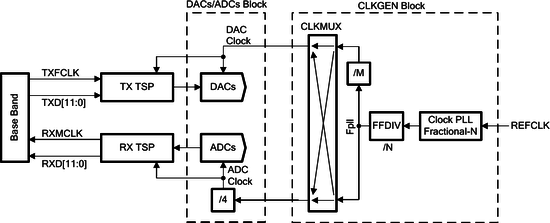
The clock generation circuit for the data converters is shown above. It shares the same reference clock input REFCLK with the RF synthesisers. The clock PLL then generates a continuous frequency range centered around 2.5 GHz. The feed forward divider (FFDIV) is programmable and capable of implementing division values as below:
There is a fixed divide by 4 within the ADC block, hence clock division on the DAC side, to provide more flexibility. There is a MUX to connect either Fpll, or Fpll/M to either ADC or DAC clocks. M is programmable and can be set to M = 1, 2, 4 or 8. The other CLKMUX output will be connected to the other data converter clock input.
TSP blocks receive the same clock as the corresponding data converter, hence there is no need for complex non-power of two or fractional interpolation/decimation. TSP blocks have programmable interpolation/decimation and generate MCLK clocks going back to the base band processor via the LimeLight™ port.
The circuit implements a continuous clock frequency range from 5 MHz to 320 MHz for the data converters. It is still possible to generate the maximum DAC clock of 640 MHz, however it is not continuous in the range of 320 MHz – 640 MHz.
Calibration and initialisation
There are a number of calibrations which the LMS7002M can carry out internally when instructed via the SPI. These calibrations can be initiated on power up/reset to produce optimum settings. Initialisation and calibration steps are summarised below.
Initialisation
- Power up the chip. In case of using multiple off-chip LDOs, power up sequence is not important.
- Apply RESET pulse (active low). This sets all the configuration registers to their default values.
- Overwrite some registers' defaults if required.
Available calibration options
Listed in recommended order of execution.
- On-chip resistor and capacitor calibration
- TX, RX and clock synthesizer VCO tuning
- TX and RX analog LPF pass band tuning
- RX DC offset and RX LO leakage cancellation
- TX DC offset and TX LO leakage cancellation
- TX IQ imbalance calibration
- RX IQ imbalance calibration
Calibration algorithms
This section shows three key calibration algorithms. Others are either similar or very simple. Please see the LMS7002M Programming and Calibration Guide and other relevant application notes for more details.
VCO tuning
In order to lock the RF or clock synthesiser while having phase noise close to optimum, VCO capacitance has to be selected carefully. A flexible algorithm, based on monitoring on chip Vtune comparators state, is described below.
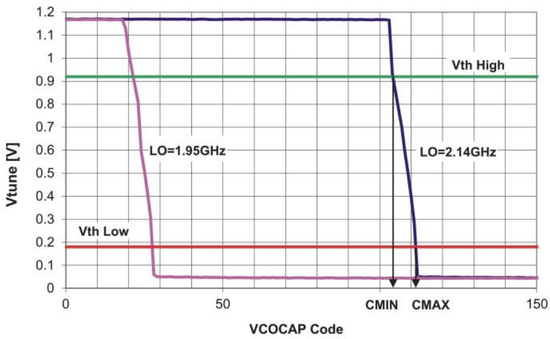
Assuming the synthesiser is configured for target LO/clock frequency (correct VCO powered up, integer and fractional part of the divider set, …), the above figure shows typical measured Vtune variation with the VCOCAP codes for the two target LO frequencies 1.95 GHz and 2.14 GHz. Vtune is changing from 1.17V down to 0.05 V. However, PLL lock is guaranteed only when Vtune is in the range 0.18 V-0.92 V. Also, for the best phase noise performance, Vtune should be kept around the middle of the range i.e. 0.55 V.
There are two on chip Vtune comparators per synthesiser: CMPH and CMPL. Their threshold voltages are set to Vth High=0.92 V and Vth Low=0.18 V. The state of the comparators can be obtained by powering them up and reading the corresponding SPI register. The truth table is given below.
| CMPH | CMPL | Status |
|---|---|---|
| 1 | 0 | OK, Vtune in range |
| 0 | 0 | Vtune is high (>0.92 V), PLL lock not guaranteed |
| 1 | 1 | Vtune is low (<0.18 V), PLL lock not guaranteed |
| 0 | 1 | Not possible |
These can be used to choose VCOCAP code. All we need to find is the code CMIN when comparators change the state from “00” to “10” and the code CMAX when the comparators change the state from “10” to “11”. Optimum VCOCAP code is then the middle one between CMIN and CMAX. For LO=2.4 GHz, this is illustrated in the earlier graph. In this case, optimum code is around 108.
Once the synthesiser is set, Vtune comparators can also be used as lock (in range) indicators.
Analogue filters pass band tuning
The LMS7002M has six analogue low-pass filtering stages. The pass band of each stage can independently be programmed and/or tuned. Tuning is very useful as it takes into account process, temperature, sample-to-sample and voltage supply variations. The algorithm uses on chip options as follows:
- TXNCO generates digital test tones (CW).
- Digital test tones are converted into analog by the DACs.
- INVERSE sinc filter must be enabled to flatten DACs amplitude response.
- LMS7002M is set into either base-band or RF TX-to-RX loop back mode.
- Only LPF being tuned should be enabled. Other TX and RX filters should be bypassed or widely open.
- Loop back signal is converted back into digital domain by the ADCs.
- Digital RX RSSI block measures the amplitude of the loop back signal.
All filtering stages are implemented as active RC blocks hence their pass band is controllable by changing resistors and/or capacitors. Only two parameters per stage are available to change via SPI: one for filter resistors control and another one for capacitors control. If the resistors control parameter is changed then all resistors within the filter are scaled equally; if the capacitors control code is changed then all capacitors within the filter are scaled equally. Therefore, component ratio is kept constant which preserves designed filter amplitude response (Chebyshev for example) disregarding the control codes.
There are two types of filter stages: trans-impedance (TXLPFLAD, TXLPFH, RXTIA) and voltage gain (TXLPFS5, RXLPFL, RXLPFH). Tuning is essentially the same for all stages with minor differences between trans-impedance and voltage gain types. The algorithm is two steps process described below and illustrated in the following figure.
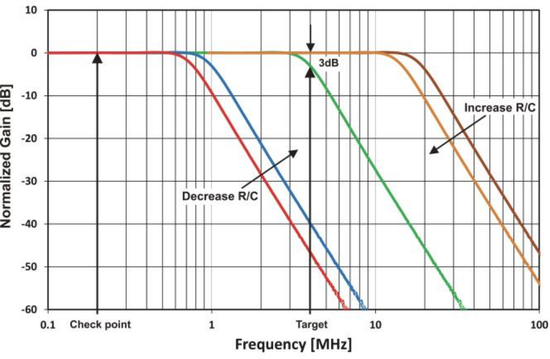
Step 1: Checkpoint
TXNCO generates very low frequency (close to DC) test tone (200 kHz in the previous figure) which is by design guaranteed to be within filter pass band for all possible RC values.
Tune the gain of the measurement loop (use DACs current amplifiers and RXPGA) to get RSSI reading few dB backed off from its maximum. This maximises the measurement dynamic range while still having some margin to measure filter gain which may be higher than the gain at low frequencies due to in band amplitude ripple.
Step 2: RC search
- TXNCO generates a test tone which is the target 3 dB cut-off frequency (4 MHz in the previous figure).
- Alter C components of the filter to get RSSI reading 3 dB below the reading obtained at the end of step 1.
- If step 2 fails to reach the target, change R components of the filter. If filter stage is trans-impedance go to step 1, otherwise go to step 2. Note that changing R in the trans-impedance stage changes its gain, hence the need to repeat step 1.
DC offset and IQ imbalance calibration
In order to show the basis of this kind of calibrations, let us first analyse a scenario with the LMS7002M configured as below.
- Drive TXTSP with digital 12-bit two’s complement DC i.e.
- TXI = 011111111111 = +max 12-bit word
- TXQ = 10000000000 = -max 12-bit word
- This can be done through the on-chip test option, no need to engage LimeLight™ with assistance from BB.
- Bypass IQ Gain Correction, IQ Phase Correction and TX DC Correction TXTSP blocks. Keep INVERSE sinc filter running.
- Configure TXLPF pass band to be able to filter DAC images.
- Tune TX Synthesiser to . Tune RX Synthesiser to offset from by a few MHz and keep .
- Close RF Loopback switch.
- Set TXPAD, RXTIA and RXPGA gain not to overload ADCs.
- Open RXLPF pass band as much as possible to clearly see all tones generated in this setup.
- Bypass IQ Gain Correction, IQ Phase Correction and RX DC Correction RXTSP blocks. Bypass Decimation filter to see all tones generated by the whole setup.
- Set RXNCO frequency to 0. Set TXNCO to where
The test setup described above uses minimum filtering to clearly show unwanted tones we need to cancel. The following spectrum diagram shows RX output while LMS7002M works in RF loopback mode. Tones and the reasons for their existence are as below.
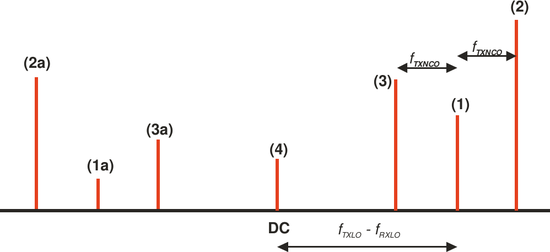
- (1) TX DC and TX LO leakage. It is down converted by fRXLO hence it appears in BB frequencies at fTXLO-fRXLO
- (2) This is wanted TX sideband. Offset from TX LO leakage by TXNCO frequency .fTXNCO.
- (3) Unwanted TX sideband caused by TX IQ imbalance.
- (4) RX DC offset and RX LO leakage. Appears at DC.
- (3a) RX unwanted side band caused by component (3)
- (1a) RX unwanted side band caused by component (1)
- (2a) RX unwanted side band caused by component (2)
Note that all tones at negative frequencies are the consequence of RX IQ imbalance.
The previous figure shows that with single measurement we can capture all tones we need to cancel. There are two problems with this approach. First, we need to perform complex FFT which is computationally intensive, i.e. it takes a long time. The on-chip MCU is not computationally powerful enough, so FFT has to be done by the BB processor which we want to avoid. The alternative would be to use digital RSSI for measurement instead of FFT. RSSI can accurately measure only single tone, not the multiple tones present in the previous figure. Fortunately, choosing the order of calibration steps carefully and with the help of on-chip available options (digital and/or analogue filters, TX and RX NCOs) this is possible.
TX IQ imbalance calibration steps are shown here as an illustration. Other calibration steps are similar. Let us assume that RX DC/LO leakage as well as TX DC/LO leakage calibration steps have already been performed, i.e. tones (1), (1a), and (4) are minimised. In this case we will have four remaining tones as shown in the below figure.
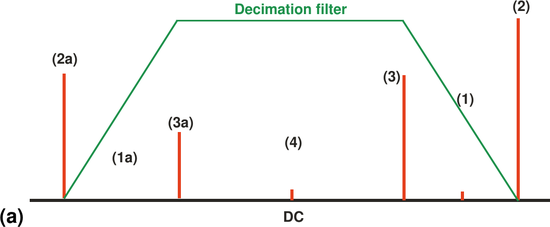
The goal of this calibration is to minimize tone (3) keeping wanted tone (2) untouched. Tone (2) will introduce a huge error if present in RSSI measurement, so some filtering will be required. Decimation filter is used for this purpose rather than general purpose FIR filters due to the fact that decimation filter is much simpler and faster to configure. The resulting spectrum after digital filtering is shown in the figure below.
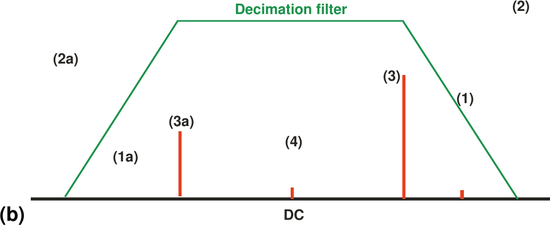
The same spectrum of the above figure drives the digital RSSI block. In fact, RSSI measures the level of the two-tone signal (3) and (3a), where (3a) is due to RX IQ imbalance. However, tones are correlated; in other words when minimising (3), tone (3a) will go down by the same amount. The RSSI output will be a composite power level of those two tones and is a valid measurement. If we minimise RSSI output we are minimising TX IQ imbalance disregarding the presence of two (correlated) tones.
The algorithm, then, is simple. First alter the on-chip analogue IQ phase correction parameters, if available, to minimise RSSI output. After that alter the TX gain correction and TX phase correction parameters of the TXTSP digital block to further minimise RSSI output. The resulting spectrum is shown in the following figure.
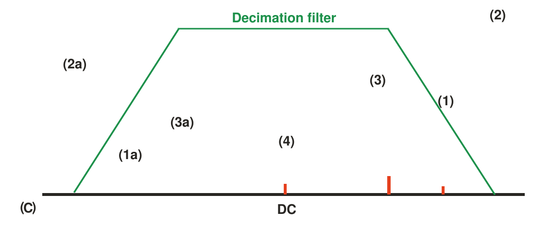
TDD/FDD mode enhancement option
In both TDD and FDD mode the LMS7002M is capable of running from a single PLL, allowing one on-chip PLL to be powered down. In TDD mode, a single PLL output drives both TX and RX mixers; in FDD mode, a single PLL drives both mixers as well while UL/DL frequency separation is implemented in the digital domain using the NCO and complex mixer parts of the TSP block. The maximum frequency shift range which can be achieved in the digital domain is as below:
where and are effective TX and RX LO frequencies, is the shared PLL output frequency while and are data converter sampling rates. Note that the Nyquist frequency of the NCOs is scaled by a factor of 0.6 to make space for TXLPF and RXLPF to operate.
Running the LMS7002M in single PLL mode has the following advantages:
- Current consumption is significantly reduced since one PLL is powered down.
- Fast TX<->RX switching time in TDD mode is achievable since the PLL does not need to relock.
- There is no TXVCO<->RXVCO polling issue since a single PLL is used.
- Using the digital domain for LO frequency shifts enables implementation of very fast frequency hopping systems.
Improving fractional-N close-to-integer RF synthesiser spurs performance
Due to the PFD/CHP ‘dead zone,’ i.e. nonlinearity around zero, fractional-N synthesisers are prone to generate unwanted spurs when set close to integer frequency. These spurs are unfortunately in the loop-pass band and cannot be filtered. One of the solutions is to set constant charge pump current offset to shift PFD/CHP away from zero, i.e. operating them in a more linear region. However, this CHP offset value depends on how far PLL output frequency is away from the nearest integer frequency and has to be tuned accordingly.
Digital blocks can help this case. Set the charge pump offset current to some middle value and keep it constant disregarding how far close-to-integer frequency is away from integer frequency. Offset the PLL wanted frequency away enough from integer frequency in order not to have close-to-integer spurs issue. This introduces a PLL output frequency error which can be corrected by a corresponding NCO available in the digital TSB block.
Package outline and pin description
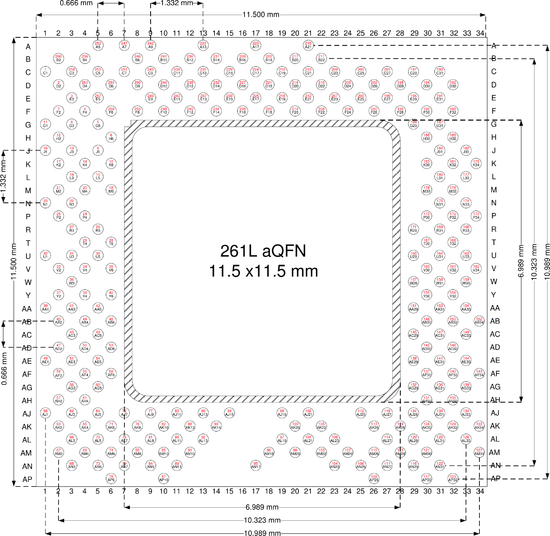
| Pin No. | Pin ID | Pin Name | Type | Description | Notes |
|---|---|---|---|---|---|
| 1 | C1 | UNUSED | - | - | |
| 2 | D2 | UNUSED | - | - | |
| 3 | E3 | UNUSED | - | - | |
| 4 | F4 | UNUSED | - | - | |
| 5 | G5 | VDD12_TXBUF | analogue supply | 1.25V supply – TX XOSC buffer | |
| 6 | H6 | VDD18_TXBUF | analogue supply | 1.8V supply – TX XOSC buffer | |
| 7 | F2 | UNUSED | - | - | |
| 8 | G3 | VDD18_VCO_SXT | analogue supply | 1.8V supply – TX SX VCO | |
| 9 | J5 | VDD12O_VCO_SXT | analogue supply | 1.25V supply – TX SX VCO | |
| 10 | K6 | VDD12_VCO_SXT | analogue supply | 1.25V supply – TX SX VCO | |
| 11 | G1 | UNUSED | - | - | |
| 12 | H2 | GND_VCO_SXT | analogue gnd | GND – TX SX VCO | |
| 13 | J3 | VDD_CP_SXT | analogue supply | 1.25V supply – TX SX Charge pump | |
| 14 | K4 | GND_CP_SXT | analogue gnd | GND – TX SX Charge pump | |
| 15 | L5 | VDD_DIV_SXT | analogue supply | 1.25V supply – TX SX frequency divider | |
| 16 | J1 | UNUSED | - | - | |
| 17 | K2 | VDDO_DIV_SXT | analogue supply | 1.25V supply – TX SX frequency divider | |
| 18 | M6 | UNUSED | - | - | |
| 19 | L3 | GND_DIV_SXT | analogue gnd | GND – TX SX frequency divider | |
| 20 | M4 | DVDD_SXT | digital supply | 1.25V supply – digital supply for TX SX | |
| 21 | M2 | UNUSED | - | - | |
| 22 | N3 | DGND_SXT | digital gnd | GND – digital supply for TX SX | |
| 23 | N1 | VDD18_LDO_TX | analogue supply | 1.8V supply – TX LDO | |
| 24 | P4 | VDD_TBB | analogue supply | 1.25V supply – TX baseband | |
| 25 | P2 | tbbqn_pad_1 | in | TX change input pad to externally drive the TX BB Channel 1 | |
| 26 | R5 | tbbin_pad_1 | in | TX change input pad to externally drive the TX BB Channel 1 | |
| 27 | R3 | tbbqp_pad_1 | in | TX change input pad to externally drive the TX BB Channel 1 | |
| 28 | T6 | tbbin_pad_2 | in | TX change input pad to externally drive the TX BB Channel 2 | |
| 29 | T4 | tbbip_pad_1 | in | TX change input pad to externally drive the TX BB Channel 1 | |
| 30 | U5 | adcin_in_1 | in | ADC input pads – To use external filtering Channel 1 | |
| 31 | U3 | tbbqp_pad_2 | in | TX change input pad to externally drive the TX BB Channel 2 | |
| 32 | U1 | tbbqn_pad_2 | in | TX change input pad to externally drive the TX BB Channel 2 | |
| 33 | V2 | tbbip_pad_2 | in | TX change input pad to externally drive the TX BB Channel 2 | |
| 34 | V4 | adcin_ip_1 | in | ADC input pads – To use external filtering Channel 1 | |
| 35 | V6 | adcin_in_2 | in | ADC input pads – To use external filtering Channel 2 | |
| 36 | W3 | adcin_qn_1 | in | ADC nput pads – To use external filtering Channel 1 | |
| 37 | Y2 | adcin_qp_1 | in | ADC input pads – To use external filtering Channel 1 | |
| 38 | Y4 | adcin_qn_2 | in | ADC input pads – To use external filtering Channel 2 | |
| 39 | AA1 | adcin_ip_2 | in | ADC input pads – To use external filtering Channel 2 | |
| 40 | Y6 | rbbip_pad_1 | out | RX BB output – To use external filtering Channel 1 | |
| 41 | AA3 | adcin_qp_2 | in | ADC input pads – To use external filtering Channel 2 | |
| 42 | AA5 | rbbqn_pad_1 | out | RX BB output – To use external filtering Channel 1 | |
| 43 | AB2 | rbbin_pad_1 | out | RX BB output – To use external filtering Channel 1 | |
| 44 | AB4 | rbbqp_pad_1 | out | RX BB output – To use external filtering Channel 1 | |
| 45 | AC3 | rbbin_pad_2 | out | RX BB output – To use external filtering Channel 2 | |
| 46 | AB6 | rbbqn_pad_2 | out | RX BB output – To use external filtering Channel 2 | |
| 47 | AD2 | rbbip_pad_2 | out | RX BB output – To use external filtering Channel 2 | |
| 48 | AC5 | rbbqp_pad_2 | out | RX BB output – To use external filtering Channel 2 | |
| 49 | AE1 | UNUSED | - | - | |
| 50 | AD4 | VDD14_RBB | analogue supply | 1.4V supply- RX baseband | |
| 51 | AE3 | VDD18_TIA_RFE | analogue supply | 1.8V supply- RXFE TIA | |
| 52 | AF2 | VDD14_TIA_RFE | analogue supply | 1.4V supply- RXFE TIA | |
| 53 | AD6 | VDD12_TIA_RFE | analogue supply | 1.25V supply- RXFE TIA | |
| 54 | AE5 | UNUSED | - | - | |
| 55 | AF4 | VDD18_LDO_RX | analogue supply | 1.8V supply- RX LDO | |
| 56 | AG2 | UNUSED | - | - | |
| 57 | AH2 | UNUSED | - | - | |
| 58 | AJ1 | UNUSED | - | - | |
| 59 | AF6 | VDD14_LNA_RFE | analogue supply | 1.4V supply- RXFE LNA | |
| 60 | AG5 | VDD12_LNA_RFE | analogue supply | 1.25V supply- RXFE LNA | |
| 61 | AH4 | UNUSED | - | - | |
| 62 | AJ3 | UNUSED | - | - | |
| 63 | AK2 | UNUSED | - | - | |
| 64 | AJ5 | UNUSED | - | - | |
| 65 | AK4 | UNUSED | - | - | |
| 66 | AL3 | UNUSED | - | - | |
| 67 | AM2 | UNUSED | - | - | |
| 68 | AN3 | rfgp_w_RFE_2 | in | LNA input gate Wideband LNA – Gate : Channel 2 | |
| 69 | AM4 | rfgn_w_RFE_2 | in | LNA input gate Wideband LNA – Gate : Channel 2 | |
| 70 | AL5 | UNUSED | - | - | |
| 71 | AK6 | UNUSED | - | - | |
| 72 | AJ7 | rfsn_l_RFE_2 | in/out | LNA Lowband LNA – Source: Channel 2 | |
| 73 | AN5 | rfgp_l_RFE_2 | in | LNA input gate Lowband LNA – Gate : Channel 2 | |
| 74 | AM6 | UNUSED | - | - | |
| 75 | AL7 | UNUSED | - | - | |
| 76 | AK8 | UNUSED | - | - | |
| 77 | AJ9 | rfsp_l_RFE_2 | in/out | LNA Lowband LNA – Source : Channel 2 | |
| 78 | AP6 | rfgn_l_RFE_2 | in | LNA input gate Lowband LNA – Gate : Channel 2 | |
| 79 | AN7 | rfgp_h_RFE_2 | in | LNA input gate Highband LNA – Gate : Channel 2 | |
| 80 | AM8 | rfgn_h_RFE_2 | in | LNA input gate Highband LNA – Gate : Channel 2 | |
| 81 | AL9 | UNUSED | - | - | |
| 82 | AK10 | UNUSED | - | - | |
| 83 | AJ11 | UNUSED | - | - | |
| 84 | AN9 | rfgp_w_RFE_1 | in | LNA input gate Wideband LNA – Gate : Channel 1 | |
| 85 | AM10 | UNUSED | - | - | |
| 86 | AL11 | UNUSED | - | - | |
| 87 | AP10 | rfgn_w_RFE_1 | in | LNA input gate Wideband LNA – Gate : Channel 1 | |
| 88 | AK12 | rfsn_l_RFE_1 | in/out | LNA Lowband LNA – Source : Channel 1 | |
| 89 | AN11 | rfgp_l_RFE_1 | in | LNA input gate Lowband LNA – Gate : Channel 1 | |
| 90 | AJ13 | UNUSED | - | - | |
| 91 | AM12 | rfgn_l_RFE_1 | in | LNA input gate Lowband LNA – Gate : Channel 1 | |
| 92 | AL13 | rfsp_l_RFE_1 | in/out | LNA Lowband LNA – Source : Channel 1 | |
| 93 | AK14 | rfgp_h_RFE_1 | in | LNA input gate Highband LNA – Gate : Channel 1 | |
| 94 | AJ15 | rfgn_h_RFE_1 | in | LNA input gate Highband LNA – Gate : Channel 1 | |
| 95 | AN17 | VDD_MXLOBUF_RFE | analogue supply | 1.25V supply: RX LO buffers | |
| 96 | AM18 | VDD18_SXR | analogue supply | 1.8V supply: RX SX | |
| 97 | AL19 | VDD_CP_SXR | analogue supply | 1.25V supply: RX SX Charge pump | |
| 98 | AJ19 | GND_CP_SXR | analogue gnd | GND: RX SX Charge pump | |
| 99 | AM20 | VDD_DIV_SXR | analogue supply | 1.25V supply: RX SX frequency divider | |
| 100 | AK20 | GND_DIV_SXR | analogue gnd | GND: RX SX frequency divider | |
| 101 | AL21 | DVDD_SXR | digital supply | 1.25V digital supply: RX SX f | |
| 102 | AJ21 | UNUSED | - | - | |
| 103 | AM22 | DGND_SXR | digital gnd | GND: RX SX | |
| 104 | AN23 | VDD12_VCO_SXR | analogue supply | 1.25V supply: RX SX | |
| 105 | AK22 | VDD18_VCO_SXR | analogue supply | 1.8V supply: RX SX | |
| 106 | AL23 | GND_VCO_SXR | analogue gnd | GND: RX SX VCO | |
| 107 | AM24 | xoscin_rx | in | ||
| 108 | AN25 | GND_RXBUF | analogue gnd | GND – RX XOSC buffer | |
| 109 | AP26 | VDD12_RXBUF | analogue supply | 1.25V supply – RX XOSC buffer | |
| 110 | AM26 | VDD18_RXBUF | analogue supply | 1.8V supply – RX XOSC buffer | |
| 111 | AN27 | UNUSED | - | - | |
| 112 | AJ25 | VDD_AFE | analogue supply | 1.25V supply – ADC/DAC | |
| 113 | AK26 | UNUSED | - | - | |
| 114 | AL27 | UNUSED | - | - | |
| 115 | AM28 | UNUSED | - | - | |
| 116 | AN29 | UNUSED | - | - | |
| 117 | AP30 | UNUSED | - | - | |
| 118 | AJ27 | UNUSED | - | - | |
| 119 | AK28 | UNUSED | - | - | |
| 120 | AL29 | UNUSED | - | - | |
| 121 | AM30 | UNUSED | - | - | |
| 122 | AN31 | UNUSED | - | - | |
| 123 | AP32 | UNUSED | - | - | |
| 124 | AJ29 | UNUSED | - | - | |
| 125 | AL31 | UNUSED | - | - | |
| 126 | AK30 | UNUSED | - | - | |
| 127 | AM34 | UNUSED | - | - | |
| 128 | AL33 | UNUSED | - | - | |
| 129 | AK32 | UNUSED | - | - | |
| 130 | AJ31 | UNUSED | - | - | |
| 131 | AH30 | DIGPRVDD2 | DVDD | Digital Pad Ring power supply for post-driver | |
| 132 | AG29 | DIGPRGND1 | pad gnd | Digital Pad Ring ground for pre-driver | |
| 133 | AK34 | UNUSED | - | - | |
| 134 | AJ33 | UNUSED | - | - | |
| 135 | AH32 | UNUSED | - | - | |
| 136 | AG31 | DIQ1_D0 | IO_cmos1225 | DIQ bus, bit 0. LML Port 1 | |
| 137 | AF30 | DIQ1_D1 | IO_cmos1225 | DIQ bus, bit 1. LML Port 1 | |
| 138 | AE29 | DIGPRVDD1 | DVDD | Digital Pad Ring power supply for pre-driver | |
| 139 | AG33 | UNUSED | - | - | |
| 140 | AF32 | DIGPRGND2 | pad gnd | Digital Pad Ring ground for post-driver | |
| 141 | AE31 | DIQ1_D3 | IO_cmos1225 | DIQ bus, bit 3. LML Port 1 | |
| 142 | AD30 | DIQ1_D4 | IO_cmos1225 | DIQ bus, bit 4. LML Port 1 | |
| 143 | AF34 | DIQ1_D2 | IO_cmos1225 | DIQ bus, bit 2. LML Port 1 | |
| 144 | AE33 | DIQ1_D6 | IO_cmos1225 | DIQ bus, bit 6. LML Port 1 | |
| 145 | AC29 | DIQ1_D5 | IO_cmos1225 | DIQ bus, bit 5. LML Port 1 | |
| 146 | AD32 | DIQ1_D7 | IO_cmos1225 | DIQ bus, bit 7. LML Port 1 | |
| 147 | AC31 | DIQ1_D8 | IO_cmos1225 | DIQ bus, bit 8. LML Port 1 | |
| 148 | AB30 | DIQ1_D10 | IO_cmos1225 | DIQ bus, bit 10. LML Port 1 | |
| 149 | AC33 | DIQ1_D9 | IO_cmos1225 | DIQ bus, bit 9. LML Port 1 | |
| 150 | AB32 | DIQ1_D11 | IO_cmos1225 | DIQ bus, bit 11. LML Port 1 | |
| 151 | AA29 | DIGPRVDD1 | DVDD | Digital Pad Ring power supply for pre-driver | |
| 152 | AB34 | MCLK1 | out_cmos1225 | Clock from RFIC to BBIC in JESD207 mode. LML Port 1 | |
| 153 | AA31 | DIGPRGND1 | DGND | Digital Pad Ring ground for pre-driver | |
| 154 | AA33 | FCLK1 | in_cmos1225 | Clock from BBIC to RFIC in JESD207 mode. LML Port 1 | |
| 155 | Y30 | DIGPRGND2 | pad gnd | Digital Pad Ring ground for post-driver | |
| 156 | Y32 | ENABLE_IQSEL1 | IO_cmos1225 | IQ flag in RXTXIQ mode; enable flag in JESD207 mode. LML Port 1 | |
| 157 | W29 | DIGPRGND1 | pad gnd | Digital Pad Ring ground for pre-driver | |
| 158 | W31 | DIGPRPOC | POC | POC circuit | |
| 159 | W33 | DIGPRVDD2 | DVDD | Digital Pad Ring power supply for post-driver | |
| 160 | V30 | LOGIC_RESET | analogue supply/gnd | Not used | |
| 161 | V32 | TXNRX1 | in_cmos1225 | IQ data protocol control in JESD207 mode. LML Port 1 | |
| 162 | V34 | RXEN | in_cmos1225 | RX hard power off | |
| 163 | U33 | CORE_LDO_EN | analogue supply/gnd | External enable control signal for the internal LDOs. | Should be fixed to analogue supply if internal LDOs are used. Should be fixed to analogue gnd if internal LDOs are NOT used. |
| 164 | U31 | TXNRX2 | in_cmos1225 | IQ data protocol control in JESD207 mode. LML Port 2 | |
| 165 | U29 | TXEN | in_cmos1225 | TX hard power off | |
| 166 | T32 | DIGPRVDD2, DIGPRPOC | DVDD | Digital Pad Ring power supply for post-driver and POC | |
| 167 | T30 | DIGPRGND1, DIGPRGND2 | pad gnd | Digital Pad Ring ground for pre-driver and post-driver | |
| 168 | R33 | ENABLE_ IQSEL2 | IO_cmos1225 | IQ flag in RXTXIQ mode; enable flag in JESD207 mode. LML Port 2 | |
| 169 | R31 | DIGPRVDD1 | DVDD | Digital Pad Ring power supply for pre-driver | |
| 170 | P34 | MCLK2 | out_cmos1225 | Clock from RFIC to BBIC in JESD207 mode. LML Port 2 | |
| 171 | R29 | FCLK2 | in_cmos1225 | Clock from BBIC to RFIC in JESD207 mode. LML Port 2 | |
| 172 | P32 | DIQ2_D11 | IO_cmos1225 | DIQ bus, bit 11. LML Port 2 | |
| 173 | P30 | DIQ2_D10 | IO_cmos1225 | DIQ bus, bit 10. LML Port 2 | |
| 174 | N33 | DIQ2_D9 | IO_cmos1225 | DIQ bus, bit 9. LML Port 2 | |
| 175 | N31 | DIQ2_D8 | IO_cmos1225 | DIQ bus, bit 8. LML Port 2 | |
| 176 | M32 | DIQ2_D7 | IO_cmos1225 | DIQ bus, bit 7. LML Port 2 | |
| 177 | L33 | DIGPRVDD1 | DVDD | Digital Pad Ring power supply for pre-driver | |
| 178 | M30 | DIQ2_D6 | IO_cmos1225 | DIQ bus, bit 6. LML Port 2 | |
| 179 | K34 | DIQ2_D5 | IO_cmos1225 | DIQ bus, bit 5. LML Port 2 | |
| 180 | L31 | DIQ2_D4 | IO_cmos1225 | DIQ bus, bit 4. LML Port 2 | |
| 181 | K32 | DIQ2_D3 | IO_cmos1225 | DIQ bus, bit 3. LML Port 2 | |
| 182 | J33 | DIGPRGND1 | DGND | Digital Pad Ring ground for pre-driver | |
| 183 | K30 | DIQ2_D2 | IO_cmos1225 | DIQ bus, bit 2. LML Port 2 | |
| 184 | J31 | DIQ2_D1 | IO_cmos1225 | DIQ bus, bit 1. LML Port 2 | |
| 185 | H32 | DIGPRVDD2 | DVDD | Digital Pad Ring supply for post-driver | |
| 186 | H30 | DIQ2_D0 | IO_cmos1225 | DIQ bus, bit 0. LML Port 2 | |
| 187 | G31 | DIGPRGND2 | pad gnd | Digital Pad Ring ground for post-driver | |
| 188 | F32 | UNUSED | - | - | |
| 189 | G29 | UNUSED | - | - | |
| 190 | F30 | SDIO | IO_cmos1225 | Serial port data input-output in 3 wire mode, Serial port data input in 4 wire mode, CMOS | |
| 191 | E31 | UNUSED | - | - | |
| 192 | D32 | UNUSED | - | - | |
| 193 | C31 | UNUSED | - | - | |
| 194 | D30 | UNUSED | - | - | |
| 195 | E29 | UNUSED | - | - | |
| 196 | F28 | SDO | out_cmos1225 | Serial port data output, CMOS | |
| 197 | C29 | SCLK | in_cmos1225 | Serial port clock, positive edge sensitive, CMOS | |
| 198 | D28 | SEN | in_cmos1225 | Serial port enable, active low, CMOS | |
| 199 | E27 | RESET | in_cmos1225 | Hardware reset, active low, CMOS level | |
| 200 | F26 | UNUSED | - | - | |
| 201 | C27 | SCL | IO_cmos1225 | uControler | |
| 202 | D26 | SDA | IO_cmos1225 | uControler | |
| 203 | E25 | GND_SPI_BUF | digital gnd | GND – SPI buffer | |
| 204 | F24 | VDD_SPI_BUF | digital supply | 1.25V supply – SPI buffer | |
| 205 | C25 | VDD12_DIG | digital supply | output 1.2V supply for digital LDO | |
| 206 | D24 | VDD18_DIG | digital supply | 1.8V supply for digital LDO | |
| 207 | E23 | UNUSED | - | - | |
| 208 | F22 | tstdo<1> | out_cmos1225 | digital output test pin | |
| 209 | C23 | GND_DIG | digital gnd | GND for the digital LDO | |
| 210 | D22 | tstdo<0> | out_cmos1225 | digital output test pin | |
| 211 | B22 | tstao | out_cmos1225 | analogue test pin | |
| 212 | E21 | VDD18_VCO_CGEN | analogue supply | 1.8V supply – VCO CLKGEN | |
| 213 | C21 | VDD14_VCO_CGEN | analogue supply | 1.4V supply – VCO CLKGEN | |
| 214 | F20 | VDD_CP_CGEN | analogue supply | 1.25V supply – Charge Pump – CLKGEN | |
| 215 | A21 | UNUSED | - | - | |
| 216 | D20 | GND_DIV_CGEN | analogue gnd | GND –frequency divider – CLKGEN | |
| 217 | B20 | GND_CP_CGEN | analogue gnd | GND –Charge Pump – CLKGEN | |
| 218 | E19 | VDD_DIV_CGEN | analogue supply | 1.25V supply – frequency divider – CLKGEN | |
| 219 | C19 | UNUSED | - | - | |
| 220 | F18 | vr_rext | in | external 10 kOhm accurate reference resistor | |
| 221 | D18 | UNUSED | - | - | |
| 222 | B18 | DGND_CGEN | digital gnd | GND – CLKGEN | |
| 223 | A17 | DVDD_CGEN | digital supply | 1.25V supply- Digital supply for CLK GEN | |
| 224 | C17 | UNUSED | - | - | |
| 225 | E17 | VDD18_BIAS | analogue supply | 1.8V supply – Bias | |
| 226 | B16 | VDD_TPAD_TRF | analogue supply | 1.25V supply – TX PAD | |
| 227 | D16 | VDD18_TRF | analogue supply | 1.8V supply – TX RF | |
| 228 | F16 | UNUSED | - | - | |
| 229 | C15 | UNUSED | - | - | |
| 230 | E15 | UNUSED | - | - | |
| 231 | B14 | pa2on_2 | out | PA driver output RF pad PAD2, Channel 2 | |
| 232 | D14 | UNUSED | - | - | |
| 233 | A13 | pa2op_2 | out | PA driver output RF pad PAD2, Channel 2 | |
| 234 | F14 | UNUSED | - | - | |
| 235 | C13 | UNUSED | - | - | |
| 236 | B12 | pa1op_2 | out | PA driver output RF pad PAD1, Channel 2 | |
| 237 | E13 | UNUSED | - | - | |
| 238 | D12 | UNUSED | - | - | |
| 239 | C11 | pa1on_2 | out | PA driver output RF pad PAD1, Channel 2 | |
| 240 | F12 | UNUSED | - | - | |
| 241 | B10 | pa2on_1 | out | PA driver output RF pad PAD2, Channel 1 | |
| 242 | A9 | pa2op_1 | out | PA driver output RF pad PAD2, Channel 1 | |
| 243 | E11 | UNUSED | - | - | |
| 244 | D10 | UNUSED | - | - | |
| 245 | C99 | UNUSED | - | - | |
| 246 | B8 | pa1op_1 | out | PA driver output RF pad PAD1, Channel 1 | |
| 247 | A7 | pa1on_1 | out | PA driver output RF pad PAD1, Channel 1 | |
| 248 | F10 | UNUSED | - | - | |
| 249 | E9 | UNUSED | - | - | |
| 250 | D8 | UNUSED | - | - | |
| 251 | C7 | GND_TLOBUF_TRF | analogue gnd | Ground for TX LO buffers | |
| 252 | A5 | UNUSED | - | - | |
| 253 | F8 | VDD_TLOBUF_TRF | analogue supply | 1.25V supply – TX LO BUFFER | |
| 254 | D6 | VDDO_TLOBUF_TRF | analogue supply | ||
| 255 | C5 | UNUSED | - | - | |
| 256 | B4 | UNUSED | - | - | |
| 257 | E5 | xoscin_tx | in | TX XOSC buffer input | |
| 258 | C3 | UNUSED | - | - | |
| 259 | F6 | GND_TXBUF | analogue gnd | GND supply – TX XOSC buffer | |
| 260 | B2 | UNUSED | - | - | |
| 261 | D4 | UNUSED | - | - |
Typical application
RF section example
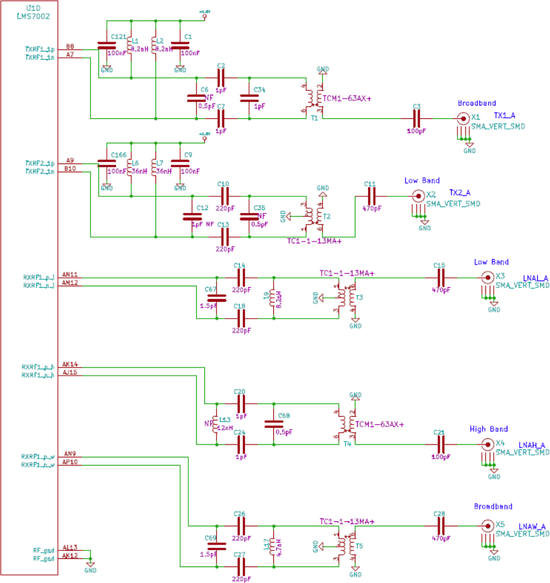
A typical application circuit of the LMS7002M is given above. Note that only the RF part of a single MIMO TRX chain is shown. More details can be found in the LMS7002M evaluation board schematics.
Digital interface configuration example
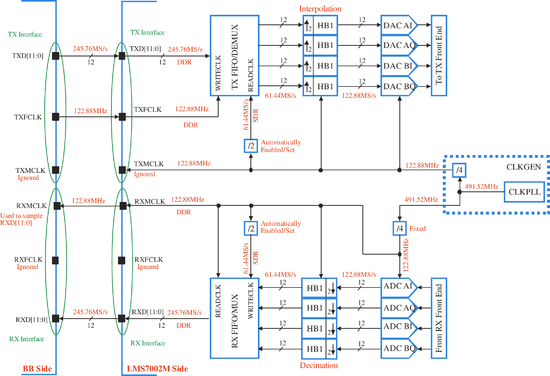
The above figure shows one useful example of clock generation and distribution as well as interfacing the LMS7002M to a digital BB modem. Note that interface control signals such as ENABLE, TXNRX, IQSEL are not shown for clarity. As can be seen, CLKPLL block generates a 491.52 MHz (integer multiple of 61.44 MHz) clock. CLKPLL output is divided by a programmable divider (division set to 4 in this example) to construct a 122.88 MHz clock driving DACs, TXTSP, and the TX part of LimeLight™. Similarly, CLKPLL output is divided by fixed division of 4 to construct 122.88 MHz clock driving ADCs, RXTSP, and the RX part of LimeLight™. Interpolation and decimation are both set to 2. This configuration provides a 245.76 MS/s double data rate (DDR) interface to the BB modem. This translates into the overall system performance as below:
- TX/RX IF bandwidth: 20MHz
- TX/RX RF bandwidth: 40MHz
- Digital interpolation image suppression: 60dB
- DACs analog image suppression: 72dB
- ADCs analog alias suppression: 43dB assuming no off chip filtering
- Digital decimation alias suppression: 60dB
Ordering information
| Model | Temperature range range | Package description |
|---|---|---|
| LMS7002M | -40°C to +85°C | 261-pin aQFN |
| LMS7002M-REEL | -40°C to +85°C | 261-pin aQFN |
| LMS7002M-EVB | Evaluation board |
Disclaimer
The information disclosed to you hereunder (the “Materials”) is provided solely for the selection and use of Lime Microsystems products. To the maximum extent permitted by applicable law: (1) Materials are made available “AS IS” and with all faults, Lime Microsystems hereby DISCLAIMS ALL WARRANTIES AND CONDITIONS, EXPRESS, IMPLIED, OR STATUTORY, INCLUDING BUT NOT LIMITED TO WARRRANTIES OF MERCHANTABILITY, NON-INFRIGEMENT, OR FITNESS FOR ANY PARTICULAR PURPOSE; and (2) Lime Microsystems shall not be liable (whether in contract or tort, including negligence, or under any other theory of liability) for any loss or damage of any kind or nature related to, arising under, or in connection with, the Materials (including your use of the Materials), including for any direct, indirect, special, incidental, or consequential loss or damage (including loss of data, profits, goodwill, or any type of loss or damage suffered as a result of any action brought by a third party) even if such damage or loss was reasonably foreseeable or Lime Microsystems had been advised of the possibility of the same. Lime Microsystems assumes no obligation to correct any errors contained in the Materials, or to advise you of any corrections or update. You may not reproduce, modify, distribute, or publicly display the Materials without prior written consent. Certain products are subject to the terms and conditions of the Limited Warranties. Lime Microsystems products are not designed or intended to be fail-safe or for use in any application requiring fail-safe performance; you assume sole risk and liability for use of Lime Microsystems products in Critical Applications.
Document Version
Based on LMS7002M Datasheet v2.8.0.
Changes since document generation:
- Minor typographical and grammatical changes.
| |||||||||||||||||||||||||

































![{\displaystyle {\begin{aligned}{\mathit {L}}=\left[{{\mathit {N}} \over 5}\right]\end{aligned}}}](https://wikimedia.org/api/rest_v1/media/math/render/svg/f1eee08e7987b11b973aaaed437c12a467eb0112)


















